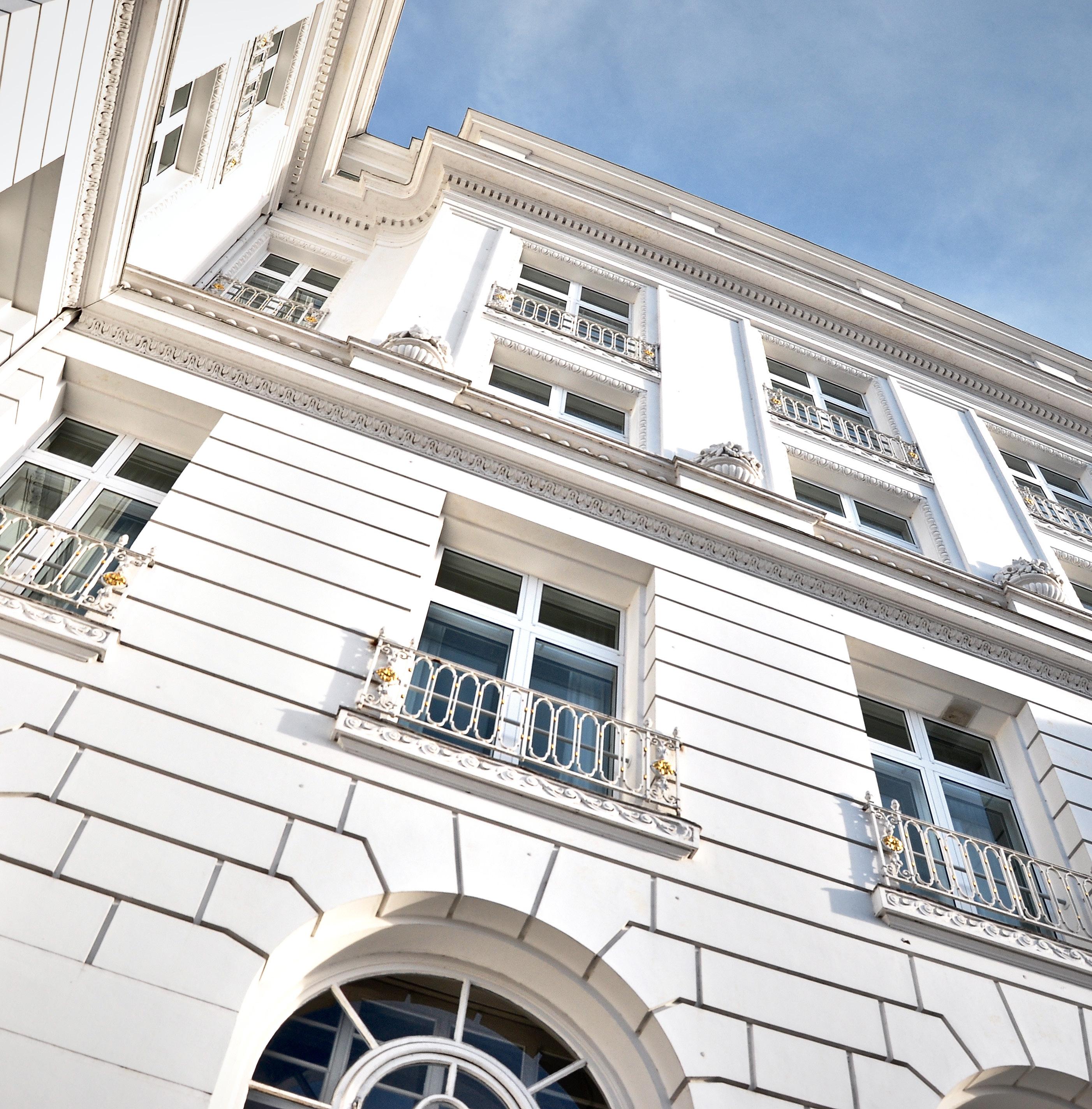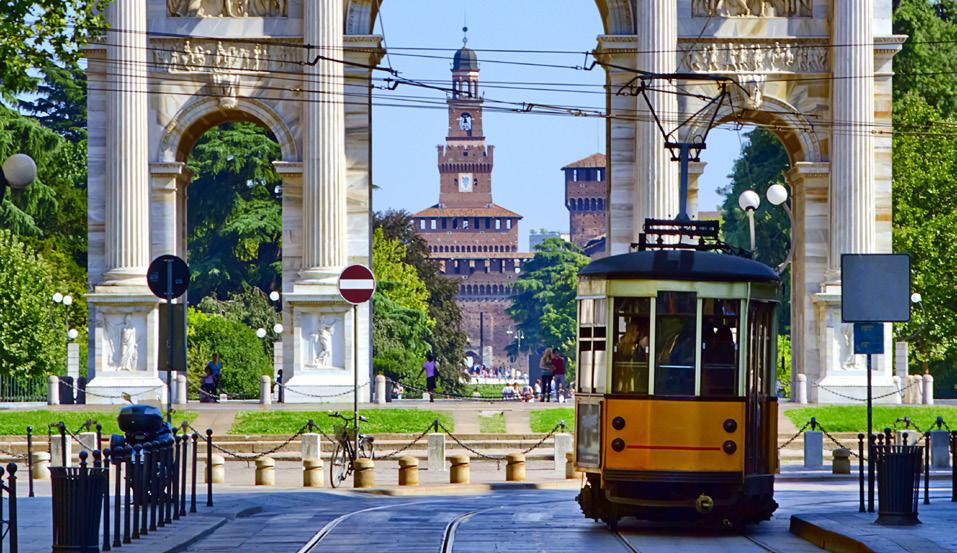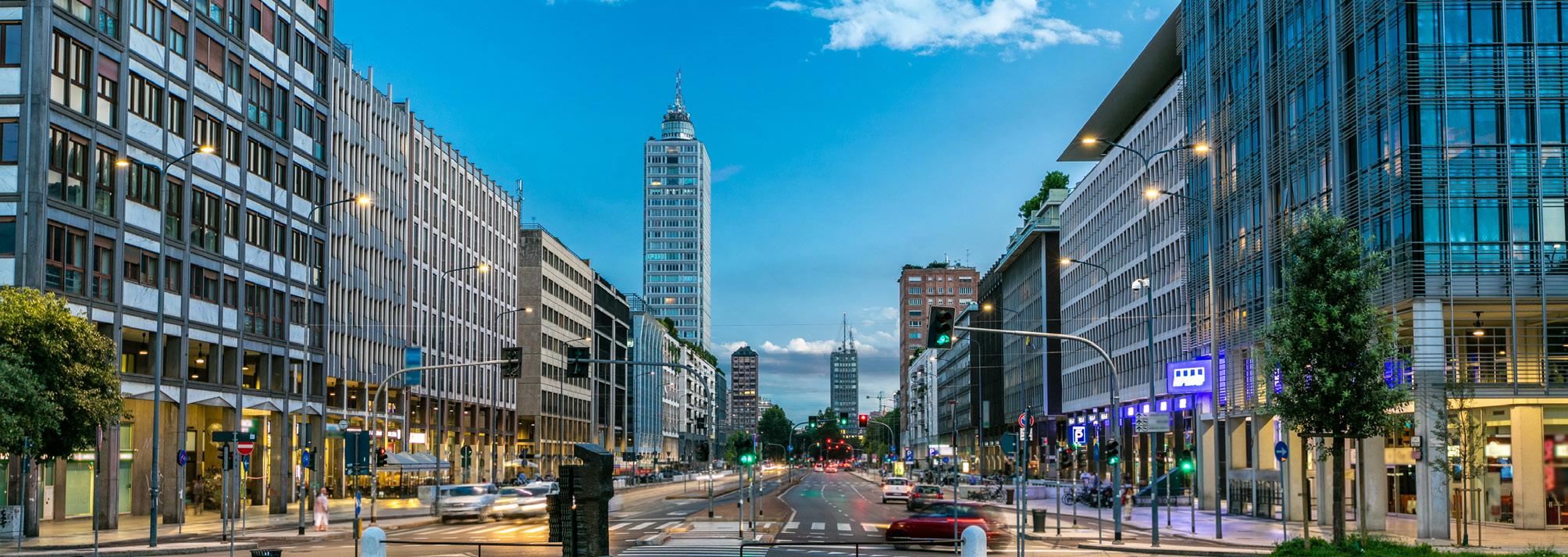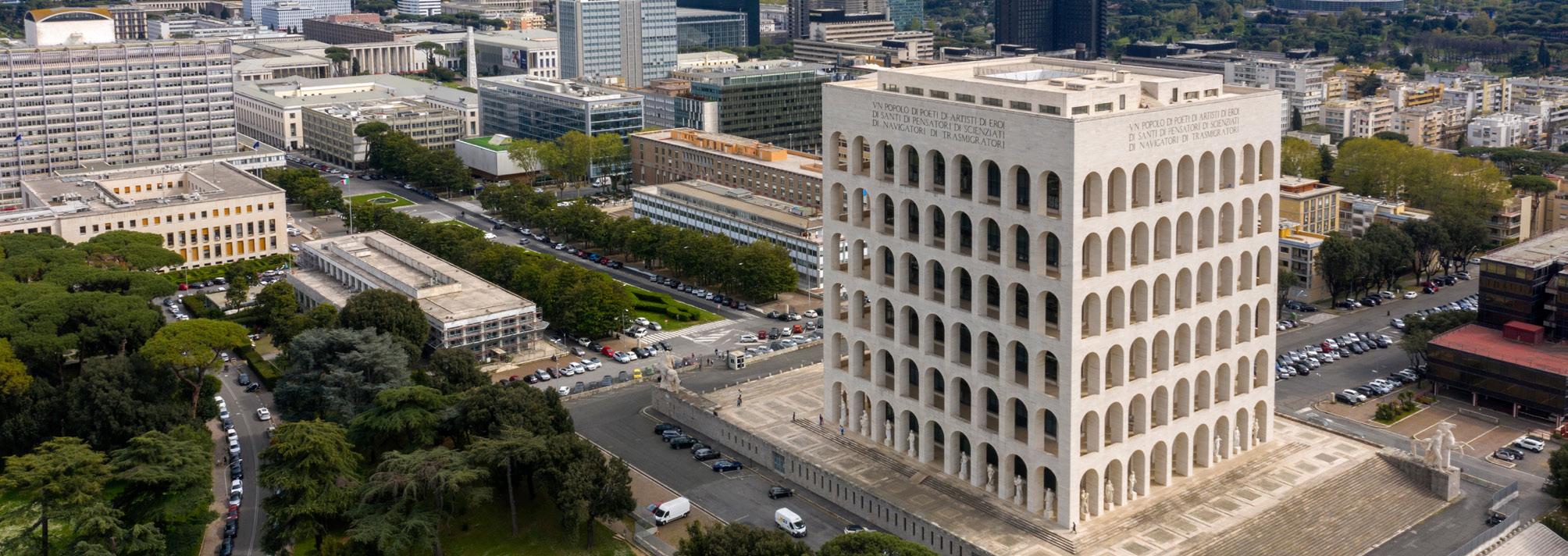
Market Report H2 2022 Milano Roma







2



3 Market Report Milano Roma H2 2022 04 08 19 30 05 17 28 31 Prodotto da Engel & Völkers. Realizzato col contributo scientifico di Nomisma. ECONOMIA ITALIANA IL MERCATO RESIDENZIALE DI PREGIO A MILANO IL MERCATO RESIDENZIALE DI PREGIO A ROMA IL MERCATO DI MILANO E ROMA IN SINTESI MERCATO IMMOBILIARE IN ITALIA IL PUNTO SU MILANO IL PUNTO SU ROMA ENGLISH VERSION MARKET REPORT MILANO ROMA H2 2022 |
Economia italiana
Scenario economico e prospettive
Nella seconda parte del 2022, l'attività economica in Italia si è indebolita, a causa sia dell’attenuazione del recupero del valore aggiunto dei servizi, ritornato sui valori prepandemici già nei mesi estivi, sia della flessione della produzione industriale. La spesa delle famiglie ha rallentato, nonostante i provvedimenti di sostegno al reddito disponibile in un contesto di elevata inflazione. In ottobre e novembre l’inflazione, misurata dall’indice armonizzato dei prezzi al consumo (fig. 1), ha raggiunto un nuovo picco (12,6%). Restano straordinariamente elevati i rincari nel settore dell’energia, dove la crescita sui 12 mesi

Inflazione al consumo e contributi delle sue parti
si colloca al di sopra del 60%. Considerando il complesso degli effetti diretti e indiretti, nella media del quarto trimestre dell’anno più del 70% dell’inflazione generale era riconducibile ai rincari dell’energia. Secondo le previsioni di Banca d’Italia, nel 2023 il PIL rallenterebbe allo 0,6%, dopo un aumento di quasi il 4% nel 2022. La crescita tornerebbe a rafforzarsi nel biennio successivo, grazie all'accelerazione delle esportazioni e della domanda interna. L'inflazione, salita quasi al 9% nello scorso anno, scenderebbe al 6,5% nel 2023 e in modo più marcato in seguito, portandosi al tasso atteso dalla Banca Centrale Europea (2,0%) nel 2025.
4
58.890.058 Popolazione (30/10/2022) +3,9% PIL 2022 var. % annua +0,4% PIL 2023 (var. % annua) +2,5% Compravendite residenziali 2022 107,0 Indice medio prezzo abitazioni Italia
Fonte: Istat, Nomisma (forecast), Engel & Völkers (prezzi e canoni)
-3 0 3 6 9 12 15 11 10 09 08 07 06 05 04 03 02 01 12 11 10 09 08 07 06 05 04 03 02 01 12 11 10 09 08 07 06 05 04 2020 2021 2022
%
MARKET REPORT MILANO ROMA H2 2022 |
Fonte: elaborazioni su Banca d’Italia su dati Eurostat
Indice armonizzato dei prezzi al consumo Componente di fondo Componente volatile
Il clima di fiducia
Per gran parte del 2022 gli indicatori di fiducia sono stati caratterizzati da un trend decrescente. Un cambio di rotta si è manifestato sul finire d’anno e, in particolare, da novembre, quando il clima di fiducia è aumentato per il secondo mese consecutivo.Per i consumatori si registra un incremento dovuto soprattutto a un’evoluzione positiva delle opinioni sulla situazione economica del paese. In particolare, il clima economico e il clima futuro registrano gli incrementi più decisi, mentre il clima personale e quello corrente aumentano in modo più contenuto.
Per le imprese, l’aumento dell’indice è veicolato principalmente da giudizi e aspettative in miglioramento sia nel comparto dei servizi sia in quello delle costruzioni e in misura minore negli altri comparti. Fa eccezione l’indice sulla manifattura, in peggioramento.

5
Fonte: elaborazioni su dati Istat
2019 | 2020 | 2021 | 2022
MARKET REPORT MILANO ROMA H2 2022 |
Consumat or i Impres e
Mercato immobiliare in Italia

Le compravendite residenziali
Il progressivo deterioramento dello scenario macroeconomico ha inevitabilmente indebolito l’andamento rialzista che, da oltre un anno e mezzo, caratterizza il mercato immobiliare italiano. La diminuzione del potere d’acquisto e d’investimento conseguente all’impennata inflativa, associata al rialzo dei tassi d’interesse, renderanno il mercato immobiliare meno accessibile per le famiglie rispetto a qualche mese fa.
La minore intensità della domanda dovrebbe portare a una riduzione dell’attività transattiva dopo lo straordinario risultato dell’ultimo anno e mezzo. La risposta dei prezzi alle mutate condizioni sarà verosimilmente rigida, con un’attenuazione della crescita, peraltro già in atto, senza rischi imminenti di un forte ridimensionamento.
In tale contesto, l’Outlook per il breve-medio termine stima un’inversione del ciclo espansivo delle compravendite residenziali già nella seconda metà del 2022, senza precludere una chiusura di anno positiva (+2,5%), con 767.000 compravendite, grazie alla performance del primo semestre, molto superiore alle attese (+10,1% su H1 2021).
L’andamento dei prezzi
Gli indici medi trimestrali dei prezzi, pubblicati da Banca d’Italia a gennaio 2023, mostrano con grande evidenza la progressiva divaricazione della forbice tra prezzi correnti e prezzi reali, dovuta alla fiammata inflativa degli ultimi mesi dell’anno. Nelle maggiori città, la domanda, che si conferma sostenuta, ha portato nel complesso a un incremento delle quotazioni medie del mercato. In particolare, le principali città italiane (Top 5) per livello dei prezzi medi delle abitazioni nuove o ristrutturate al nuovo presentano differenti variazioni semestrali: Milano (+2,2%), Venezia (-0,2%), Roma (+0,3%), Firenze (+2,0%) e Bologna (+1,5%). In termini di media di anno, il 2022 si è chiuso con un tasso di
crescita pari a +2,9%, a cui dovrebbe seguire un tasso del +0,7% nel 2023, che rappresenta la sintesi di andamenti molto eterogenei tra le città monitorate, dal +2,6% di Milano fino al -1,8% di Venezia.
La crescita si manterrà modesta anche nel biennio successivo, con una variazione media di +0,5% nel 2024 e di +0,7% nel 2025. Al termine del triennio di previsione, oltre a Venezia, anche le città di Bari, Napoli e Genova rimarranno su valori dei prezzi inferiori a quelli registrati nel 2022, mentre Milano, Firenze e Torino registreranno gli incrementi maggiori, intorno al 6% rispetto al 2022.
6 300 500 700 900 '25 '24 '23 '22 '21 '20 '19 '18 '17 '16 '15 '14 '13 '12 '11 '10 '09 '08 '07 '06 '05 '04 '03 '02 '01 '00
Compravendite residenziali e previsioni 2020-2025
Fonte: elaborazioni Nomisma su dati Agenzia delle Entrate
Migliaia
300 500 700 900 '25 '24 '23 '22 '21 '20 '19 '18 '17 '16 '15 '14 '13 '12 '11 '10 '09 '08 '07 '06 '05 '04 '03 '02 '01 '00 Compravendite residenziali e previsioni 2020-2025 Fonte: elaborazioni Nomisma su dati Agenzia delle Entrate Migliaia 300 500 700 900 '25 '24 '23 '22 '21 '20 '19 '18 '17 '16 '15 '14 '13 '12 '11 '10 '09 '08 '07 '06 '05 '04 '03 '02 '01 '00 Compravendite residenziali e previsioni 2020-2025
Fonte: elaborazioni Nomisma su dati Banca d’Italia (dati pubblicati a gennaio 2023)
Migliaia 2016 | 2017 | 2018 | 2019 | 2020 | 2021 | 2022
Fonte: elaborazioni Nomisma su dati Agenzia delle Entrate
Prezzi Correnti Prezzi reali
MARKET REPORT MILANO ROMA H2 2022 |
Il finanziamento immobiliare
Prosegue l'aumento del costo del credito bancario. Nel secondo semestre 2022, la Banca Centrale Europea ha aumentato due volte i tassi ufficiali, rispettivamente di 75 e 50 punti base, anticipando ulteriori incrementi a un ritmo costante, per favorire un ritorno dell'inflazione all'obiettivo di medio termine.
In Italia, il rialzo dei tassi ufficiali si è trasmesso al costo del credito bancario sostanzialmente in linea con l'incremento medio dell’Area Euro. I dati di Banca d’Italia indicano che tra agosto e novembre i prestiti bancari al settore privato non finanziario hanno rallentato, risentendo dell'indebolimento sia della domanda delle imprese per finalità di investimento, sia di quella delle famiglie per l'acquisto di abitazioni.
In tale contesto, si ritiene che le erogazioni di mutui per l’acquisto di abitazioni si avvieranno verso una fase decrescente. La diminuzione prospettata nella seconda metà del 2022 dovrebbe essere compensata dalla crescita acquisita nella prima parte, confermando sostanzialmente gli elevati livelli di credito erogati nel 2021, attestatesi oltre i 53 miliardi di euro. La fase recessiva delle erogazioni di nuovi mutui dovrebbe interessare tutto il 2023, con una diminuzione pari al 17%, per poi tornare a una modesta crescita (+1,7%) nel 2024.
7
Fonte: previsioni Nomisma a novembre 2022
Fonte: Nomisma
0 3K 6K 9K 12K 15K 18K 2025 2024 2023 2022 2021 2020 2019 2018 2017 2016 2015 Erogazioni di mutui alle famiglie Fonte: elaborazioni su dati Banca d’Italia per dati consuntivi; previsioni Nomisma Milioni di € Consuntivo Previsioni 0 3K 6K 9K 12K 15K 18K 2025 2024 2023 2022 2021 2020 2019 2018 2017 2016 2015 Erogazioni di mutui alle famiglie Fonte: elaborazioni su dati Banca d’Italia per dati consuntivi; previsioni Nomisma Milioni di € Consuntivo Previsioni MARKET REPORT MILANO ROMA H2 2022 |
Il mercato residenziale di pregio a Milano
Congiuntura e Outlook
Nei primi tre trimestri del 2022 il volume di compravendite sul mercato residenziale milanese ha registrato un incremento del 10,4% sullo stesso periodo dell’anno precedente. La buona performance, che sembra preludere una chiusura d’anno positiva, è principalmente imputabile ai risultati del primo semestre dell’anno (+17,5% la variazione tendenziale), mentre il terzo trimestre sconta, per contro, un calo del 5,1%. Il dato è in controtendenza rispetto a quello nazionale, per cui si registra un +1,2%.
L’entità del volume scambiato sul mercato a consuntivo dei tre trimestri (oltre 21.400 transazioni) è ancora tale da rappresentare il picco massimo degli ultimi dieci anni. Nonostante il quadro previsivo delineato a metà 2022; infatti, il secondo semestre dell’anno ha superato le incerte aspettative. Le forti criticità economiche, derivanti dall’aumento dei costi delle materie prime e dalla conseguente inflazione, hanno impattato solo in parte il segmento di pregio di Milano, per la parte di compravendite dipendenti dall’erogazione di mutui, a causa dell’incremento dei tassi di interesse.
Non accenna a diminuire la forte liquidità del mercato, con tempi medi di vendita di circa 1-2 mesi per gli immobili nuovi o pronti all’uso e di circa 3-4 mesi per l’usato. Lo sconto
medio sul prezzo richiesto è del 3-4% per immobili nuovi o pronti all’uso e 6-8% per immobili localizzati in zone non prime o da ristrutturare. Nel comparto della locazione, gli immobili nuovi/ristrutturati al nuovo vengono locati nel giro di poche settimane, senza scontistica; mentre le proprietà usate sono caratterizzate da tempi di locazione più lunghi (2-3 mesi), con sconti medi del 10-15%.
Sul versante dell’offerta, permane una forte carenza di prodotto di qualità a fronte di una domanda elevata. Cresce il divario tra prodotto nuovo, inteso come già costruito e ristrutturato, e il prodotto usato, che rappresentano ormai due mercati distinti.
Milano si conferma un mercato a sé, influenzato dalla vocazione internazionale della città. Come già accaduto con il successo dell’Expo 2015, l’avvicinarsi dei Giochi Olimpici e Paraolimpici Invernali Milano Cortina 2026 catalizza costantemente, e in maniera crescente, investimenti immobiliari di rilievo.
A subire un rallentamento è stato invece il comparto dei nuovi sviluppi. La fase euforica, che aveva caratterizzato il settore del new development, è stata colpita dall’aumento degli oneri di costruzione, dall’incremento dei costi e dei tassi d’interesse che hanno scoraggiato i grandi
8
1.352.943 Popolazione (30/10/2022) +10,4% Compravendite residenziali 6,8€K-11,3€K Nuovo/ristrutturato, prezzo €/mq 270-380€ Nuovo/ristrutturato, canone €/mq 21.000 € Nuovo/ristrutturato, Top Price €/mq
Fonte: Istat, Nomisma (forecast), Engel & Völkers (prezzi e canoni)
MARKET REPORT MILANO ROMA H2 2022 |
Fonte: elaborazioni Nomisma su dati Agenzia delle Entrate Fonte: Nomisma, Indice di performance residenziale
investimenti. L’interesse è rimasto elevato per la realizzazione di iniziative di piccole dimensioni, da portare a termine in breve tempo.
Il comparto della locazione ha confermato l’atteso incremento semestrale delle quotazioni, trainato dalla sostenuta domanda e dalla forte spinta inflativa. Questa ha portato immediate conseguenze in termini di contrattualistica, con la riduzione del regime della cedolare secca e un diffuso ritorno a forme contrattuali caratterizzate da rivalutazione annuale, con conseguente aumento generalizzato dei canoni.
I contratti a breve termine, 12-18 mesi, sono progressivamente più diffusi, sebbene in molte aree vi sia una forte incongruenza tra la metratura richiesta e l’offerta attuale. Gli immobili sotto i 100 mq rappresentano un prodotto sovrabbondante, mentre per le metrature oltre i 150 mq la scarsità di prodotto, e una diffusa bassa qualità degli immobili, rende difficile l’incontro tra domanda e offerta. In tale contesto l’immobile di pregio in perfette

condizioni manutentive può raggiungere canoni fuori mercato. Per entrambi i comparti, si riscontra un ritorno di interesse verso le aree più centrali, dopo l’immediata tendenza centrifuga post-pandemia. Inoltre, continua la ripresa del flusso di stranieri provenienti principalmente dall’Europa. L’efficienza energetica degli edifici è destinata ad acquistare importanza crescente sul mercato. Sebbene gli immobili con elevate prestazioni energetiche siano già più attrattivi, nel prossimo futuro le soluzioni totalmente autonome costituiranno un netto discrimine tra prodotto nuovo e usato, in particolare per le nuove realizzazioni caratterizzate da costi di consumo nulli e in grado di vendere il surplus di energia prodotto.
Tale aspetto risulta particolarmente significativo in vista dell’attuazione della nuova direttiva europea che prevede, entro il 2030, l’adeguamento di tutti gli immobili residenziali alla classe energetica E, entro il 2033 il passaggio alla classe D, con l’obiettivo di arrivare entro il 2050 a zero emissioni.
9
MARKET REPORT MILANO ROMA H2 2022 |
Fonte: Engel & Völkers
Outlook H1 2023
L’Outlook di Engel & Völkers per il primo semestre 2023 indica, per il mercato della compravendita, una situazione di mercato stazionaria rispetto al semestre precedente, con un’intonazione positiva circa l’aumento dei prezzi nella Zona Nord e nella Zona Est e, in particolare, in tutti i quartieri del Centro Storico, dove a contesti con quotazioni stazionarie si affiancano contesti in crescita. La Zona Sud, per contro, sconta attese di calo degli scambi in tutte le zone, ma con prezzi in aumento.
Sul versante della locazione, in Centro Storico prevalgono sia contesti stabili, sia spinte al rialzo di contratti e quotazioni. Nella Zona Est e nella Zona Nord i contratti, stazionari, beneficiano di un tendenziale incremento dei canoni. Sono più differenziate le prospettive per la Zona Ovest, che sul versante della locazione vede una sostanziale diminuzione dei contratti, a eccezione di alcuni quartieri più stazionari. I canoni dovrebbero confermarsi stabili. Nella Zona Sud prevalgono le attese al rialzo per tutti gli indicatori.

10
Fonte: Engel & Völkers
MARKET REPORT MILANO ROMA H2 2022 |
Prezzi e Canoni
Centro Storico
In continuità con il semestre precedente, il mercato del Centro Storico , più di altri, rimane caratterizzato da un’intonazione stazionaria delle quotazioni medie degli immobili. Per le proprietà ristrutturate al nuovo, il range si conferma straordinariamente ampio a livello di singolo quartiere, con la zona del Duomo, tra le altre, che conferma valori medi compresi nel range 8.500-18.500 EUR/mq. Le quotazioni top toccano i 20.000-21.000 EUR/mq nel Quadrilatero, a Brera e nella zona Castello-Foro Buonaparte, e i 17.000-18.000 EUR/mq a San Babila e Cordusio. Una tendenza al rialzo si riscontra invece per i canoni di locazione delle abitazioni nuove/ristrutturate, assestati sui 320-400 EUR/mq/anno, e per le abitazioni in buone condizioni sui 180-250 EUR/mq/anno.

11
MARKET REPORT MILANO ROMA H2 2022 |
Fonte: Engel & Völkers
La Zona Ovest
I prezzi medi degli immobili di pregio nella Zona Ovest confermano i livelli del semestre precedente in alcune zone, mentre in altre registrano un trend al rialzo. Le quotazioni medie per gli immobili ristrutturati al nuovo vanno dai 4.200-4.500 EUR/mq di Gambara-Bande Nere e San Siro ai circa 10.000 EUR/mq di Sempione-Arco della Pace-Chinatown e Vercelli-Washington.
Restano fuori range le quotazioni di City Life: 8.800-15.000 EUR/mq.
Aumenta leggermente il livello medio dei canoni di locazione degli immobili nuovi e ristrutturati al nuovo, compresi tra 240-340 EUR/mq/anno, mentre restano stazionarie le quotazioni delle proprietà in buone condizioni, assestate tra 200-300 EUR/mq/anno.

12
Fonte: Engel & Völkers
MARKET REPORT MILANO ROMA H2 2022 |
La Zona Est
I prezzi medi della Zona Est presentano un trend al rialzo su base semestrale in tutte le zone, più accentuato nei quartieri di Città Studi e Porta Venezia, per le residenze nuove o ristrutturate al nuovo. Per questi immobili i valori di compravendita sono compresi nel range 4.450-9.350
EUR/mq. Le quotazioni medie crescono allo stesso modo per le abitazioni da ristrutturare.Sono in aumento anche i canoni medi di locazione sia per le abitazioni nuove/ ristrutturate (250-335 EUR/mq/anno), sia per le proprietà in buone condizioni (145-190 EUR/mq/anno).

13
MARKET REPORT MILANO ROMA H2 2022 |
Fonte: Engel & Völkers
La Zona Nord
Nel semestre, i prezzi medi della Zona Nord crescono in tutti i quartieri dell’area. La Zona Nord comprende aree i cui livelli medi di prezzo distano tra loro significativamente, con un range di prezzo nelle zone Centrale-Loreto e IsolaGioia-Maggiolina di 4.900-7.150 EUR/mq per le proprietà nuove/ristrutturate.
I prezzi medi top di Porta Nuova-XXV Aprile raggiungono quota 19.500 EUR/mq. Anche l’area di Garibaldi-MoscovaArena conferma il trend al rialzo con un prezzo medio massimo di 12.800 EUR/mq.


Crescono i canoni di locazione medi su base semestrale: 260-450 EUR/mq/anno per le abitazioni nuove/ ristrutturate e 165-225 EUR/mq/anno per le abitazioni in buone condizioni.
La Zona Sud
Le quotazioni medie della Zona Sud crescono, su base semestrale, in tutte le zone, in un range che varia, per le abitazioni nuove/ristrutturate, tra 6.500 EUR/mq di Medaglie d’Oro-Lodi e 11.000 EUR/mq di Porta RomanaCrocetta-Quadronno.
Lo stesso trend si registra, in sostanza, per le residenze da ristrutturare.
Anche i canoni di locazione presentano un trend al rialzo, con incrementi di entità maggiore per gli immobili nuovi/ ristrutturati, compresi nel range 270-380 EUR/mq/anno.
Anche le abitazioni in buone condizioni, che non necessitano di lavori di ristrutturazione, mostrano un incremento dei valori.
14
MARKET REPORT MILANO ROMA H2 2022 |
Fonte: Engel & Völkers
15
Fonte: Engel & Völkers
MARKET REPORT MILANO ROMA H2 2022 |
Fonte: Engel & Völkers
16
Fonte: Engel & Völkers
MARKET REPORT MILANO ROMA H2 2022 |
Fonte: Engel & Völkers
Il Punto su Milano
Intervista
Gabriele Borgnino
Office Manager Engel & Völkers Milano Porta Romana
Petra Mojžíšová
Licence Partner Engel & Völkers Milano
Marco Sorbara
Direttore Generale Engel & Völkers Milano
Roberto Magaglio
Licence Partner Engel & Völkers Milano
D.: Qual è il trend della domanda nel II semestre 2022?
R.: Gabriele Borgnino
Dopo i primi sei mesi dell’anno, anche il secondo semestre si conferma positivo per il mercato immobiliare milanese sia per il numero di compravendite in aumento sia per i valori al rialzo. Nonostante le previsioni non fossero particolarmente ottimistiche, a causa del protrarsi del conflitto in Ucraina, in aggiunta al susseguirsi di continui rialzi dei tassi di interesse bancari, il mattone ha
probabilmente rappresentato uno dei pochi “rifugi sicuri” per gli investitori, che hanno dovuto fronteggiare l’inflazione più alta degli ultimi trent’anni. Un mercato, quello milanese, che ha dimostrato di essere in salute e particolarmente solido, e di saper fronteggiare le molte avversità che si sono susseguite nel corso degli ultimi due anni. La domanda è estremamente eterogenea e coinvolge tutte le zone della città: il centro storico mantiene alto il suo appeal per gli acquirenti più esigenti al quale si affiancano tutte le zone emergenti e in fase di riqualificazione come NoLo e Fondazione Prada che attraggono la domanda dei più giovani.
Anche per le locazioni si conferma un momento estremamente positivo; la domanda è caratterizzata da richieste provenienti da stranieri che identificano in Milano come una valida alternativa, competitiva rispetto alle altre principali città europee. Molte anche le richieste per investimento, realizzate da chi cerca un appartamento da locare con un contratto tradizionale o con la formula shortterm rental, adatta a rispondere alla crescente presenza di turisti e alla maggiore affluenza attesa in occasione dei Giochi Olimpici e Paraolimpici Invernali Milano Cortina 2026.

D.: Mercato delle locazioni: quali sono le nuove tendenze?
R: Petra Mojžíšová
Nel mercato delle locazioni, da settembre 2022, si sta progressivamente tornando a pieno regime, riguadagnando i tassi di occupazione pre-COVID-19, con la differenza che molti immobili in locazione sono passati al comparto breve termine a scapito di quello a lungo termine. Il fenomeno è opposto a quanto avevamo sperimentato con la pandemia e, sicuramente, ancora più forte, lasciando il mercato locativo a lungo termine con poco prodotto e specialmente con prodotto più vetusto e poco moderno (che verrebbe scartato sul breve termine). Il mercato locativo short-term offre, infatti, anche al netto dei pur ingenti costi di gestione, canoni mediamente più generosi con minor rischio di credito e il vantaggio di non doversi impegnare per un lungo periodo, particolarmente sentito in questo momento di forte crescita dei canoni.
Infatti, l'interrogativo lasciato sul tavolo al precedente Market Report ha avuto una risposta chiara: i canoni sono cresciuti e stanno tuttora crescendo per compensare i proprietari dell'inflazione. Da sottolineare, inoltre, l'incremento monstre delle spese condominiali (almeno +20%) dovuto ai rincari energetici che attualmente si riversa interamente sui conduttori.
Fino a dove questo fenomeno possa arrivare non è chiaro,
17
MARKET REPORT MILANO ROMA H2 2022 |
dal momento che a un certo punto si dovrà fare i conti col potere di acquisto dei conduttori, anche se, sempre di più, questi ultimi sono stranieri e generalmente poco sensibili all'aumento dei canoni.
La mobilità aziendale è tornata completamente ai livelli pre-COVID-19, così come sono tornati gli studenti fuori sede, riattivando la domanda di base del mercato locativo milanese.
Rimane il grande problema della scarsità di prodotto adeguato rispetto alle richieste della domanda, specie su dimensioni oltre i 150 mq: francamente fatichiamo a vedere una soluzione a questo problema con l'attuale regime legislativo, anche se sempre più operatori stanno buttando il cuore oltre all'ostacolo investendo nel build-to-rent su tagli medio-piccoli.
La domanda è sempre più focalizzata sul prodotto nuovo o usato ma ben ristrutturato, in zone ben servite dalla metropolitana o dai servizi di trasporto pubblico.
L'aumento dell'inflazione, praticamente sconosciuta nell'ultimo decennio, ha mandato un po' fuori moda i contratti assistiti da cedolare secca e sta creando dissapori in vecchi contratti tra conduttori e proprietari che vorrebbero cercare di aumentare i canoni per recuperare il divario con l'attuale mercato.
Per il primo semestre 2023 ci aspettiamo quindi canoni sempre in crescita e una diminuzione del numero dei contratti dovuta alla scarsità di prodotto adeguato.
D.: Rispetto alle varie zone di Milano si rilevano nuove tendenze?
R.: Marco Sorbara
Prosegue speditamente il trend di espansione del centro di Milano che ha caratterizzato gli ultimi anni, supportato dalla contestuale realizzazione di nuove costruzioni e quartieri residenziali, aree verdi e luoghi di aggregazione, così come infrastrutture e linee metropolitane. Proprio l’espansione delle linee M4 e M5 ha inciso in modo determinate sulla riqualificazione di alcune zone precedentemente isolate dal resto della città, e dunque meno richieste, che ora trovano nuova linfa e interesse nei compratori alla ricerca di soluzioni da acquistare sia per uso proprio che per investimento. Su tutte queste aree spiccano in particolare la zona Plebisciti-Argonne nel comparto est, a nord-ovest la grande area che comprende Cenisio e Piazza Firenze fino al Portello, così come a ovest l’area Bolivar, piazza Napoli e Tolstoj.
Qui si registra, a varia intensità, una maggior domanda d’acquisto e un aumento dei valori medi di scambio, in particolare per quanto riguarda le abitazioni nuove o completamente ristrutturate che rimangono target per la maggior parte degli acquirenti, in questo momento dove costi e tempi dell’edilizia incidono in modo determinante sulle scelte d’investimento.
È svanito invece il trend di uscita dalla città che aveva
caratterizzato il periodo della pandemia e che pare ora definitivamente rientrato. Questo sta favorendo l’appeal delle aree precedentemente analizzate che risultano un ottimo compromesso tra la tranquillità di una casa distante dalla frenesia del centro e una buona ubicazione ricca di servizi, verde e collegamenti.
D.: Quali sono le vostre previsioni per la prima parte del 2023?
R.: Roberto Magaglio
Nonostante il perdurare dell'instabilità e dell’incertezza economica, il mercato residenziale di pregio a Milano rimane caratterizzato da una forte domanda. Questo ci consente di rimanere moderatamente positivi sulle compravendite del primo semestre 2023, pur aspettandoci una lieve riduzione del numero di compravendite, a causa della scarsità dell’offerta.
Anche nel 2023 l’aumento dell’inflazione, associata alle evidenze sulla tenuta del mercato milanese, contribuirà a rassicurare gli investitori sulla bontà dell’investimento immobiliare, anche a causa della mancanza di valide alternative di investimento.
Milano gode ancora del grande vantaggio del rientro dei cervelli in fuga, che grazie all’internazionalità della città raccoglie la maggior parte delle preferenze di rientro. Si tratta di un flusso che non si esaurirà nel 2023 e che contribuisce in maniera importante e sostanziale alla domanda di immobili di pregio.
Per quanto riguarda gli immobili meno pregiati, il rialzo dei tassi d’interesse impatta fortemente sulla disponibilità delle banche a erogare mutui. Il persistere di questa situazione tenderà a trasmettersi anche alla parte più pregiata del mercato.
Le zone calde di Milano si confermano: la zona Fondazione Prada, già cresciuta ma ancora trainata dall'effetto dei Giochi Olimpici e Paraolimpici Invernali Milano Cortina 2026, e la zona Loreto, in particolare NoLo, in vista delle trasformazioni urbanistiche attese e del nuovo tracciato della M4. San Siro, una volta deciso il futuro dello stadio, potrebbe trovare nuova vitalità.
Nonostante l'effetto COVID-19 si stia allontanando, continuano a essere preferiti immobili con spazi esterni, specie ai piani alti e, ovviamente, in buoni contesti di zona.
La prima cerchia del centro storico, ancora in ripresa, e ricercata specialmente da stranieri, fatica ancora a crescere rispetto alle zone semi-centrali o periferiche.
Il prodotto nuovo continua a funzionare molto bene, nonostante le crescenti preoccupazioni degli sviluppatori per un possibile indebolimento dell'economia associata al rincaro delle materie prime, grazie alla scarsità di prodotto di pregio nel mercato dell'usato.
In sintesi, per la prima parte del 2023 le attese per Milano sono ancora positive, con crescenti interrogativi per l'evoluzione futura.
18 MARKET REPORT MILANO ROMA H2 2022 |
Il mercato residenziale di pregio a Roma
Congiuntura e Outlook
Nei primi nove mesi del 2022, sul mercato di Roma, sono state portate a termine 29.760 transazioni, con un incremento del 6,7% sullo stesso periodo del 2021, contribuendo così a una chiusura d’anno positiva. La buona performance è principalmente imputabile al risultato del primo semestre (+9% tendenziale), oltre che da un timido incremento del terzo trimestre (+1,9%), leggermente migliorativo rispetto al dato nazionale (+1,2%).
L’entità del volume scambiato sul mercato a consuntivo dei tre trimestri (circa 29.800 transazioni) è ancora tale da rappresentare il migliore risultato degli ultimi anni.
Con riferimento al segmento di pregio, nel secondo semestre 2022, il mercato romano ha continuato a beneficiare di una domanda sostenuta, che ha garantito una buona performance delle compravendite in molte zone, a fronte di quotazioni nel complesso stazionarie o, al più, in leggero calo, e tempi medi di vendita ridotti rispetto al semestre precedente.
Nel Centro Storico il mercato della compravendita resta dinamico, sebbene caratterizzato da tassi di crescita più ridotti di quelli straordinari del semestre precedente. A seguito del boom di compravendite del 2021 e dell’inizio del 2022, l’offerta in vendita è in riduzione e a fatica incontra le
esigenze di una domanda vivace sia per l’acquisto residenziale, sia per quello di investimento. Tra gli investitori stranieri, sempre interessati alle zone centrali di pregio, aumenta anche l’interesse per le compravendite di nuda proprietà. La domanda d’acquisto è maggiormente concentrata nelle zone di: Trastevere, Testaccio, Ponte, Borgo, Parione, Monteverde Vecchio; mentre si ravvisa una ripresa del mercato nella zona Aventino-San Saba.
Nella zona Prati-Vaticano si concentra la domanda dei residenti interessati alle zone centrali, per la maggiore presenza di spazi esterni e aree verdi rispetto al Centro Storico. L’acquisto a uso investimento qui è meno diffuso, così come la presenza di acquirenti esteri.
La Zona Nord ha visto confermare il numero di compravendite nel semestre, grazie a una domanda di acquisto stazionaria e a fronte di un lieve incremento delle proprietà offerte sul mercato. Nella zona di maggiore pregio, tra cui Parioli e Prati, la domanda è attratta dalla tipologia edilizia e dai generosi tagli degli immobili, oltre che dalla vicinanza a prestigiose aree verdi. È presente anche la domanda di investimento per le proprietà di piccole dimensioni da destinare a uso turistico o, nella zona di San Lorenzo, a locazione studentesca. Rispetto al
19
Fonte: elaborazioni Nomisma su dati Agenzia delle Entrate
Fonte: Nomisma, Indice di performance residenziale
2.744.945 Popolazione (30/10/2022) +6,7% Compravendite residenziali 3,4€K-4,8€K Nuovo/ristrutturato, prezzo €/mq 150-290€ Nuovo/ristrutturato, canone €/mq 9.000 € Nuovo/ristrutturato, Top Price €/mq MARKET REPORT MILANO ROMA H2 2022 |
Fonte: Istat, Nomisma (forecast), Engel & Völkers (prezzi e canoni)
semestre precedente è sensibilmente aumentata la domanda di acquisto da parte di clienti stranieri, provenienti dal Nord Europa.
La Zona Ovest conferma il buon livello delle compravendite del semestre precedente, con prezzi stazionari che facilitano l’incontro tra domanda e offerta. La zona di Monteverde Nuovo continua a riscuotere l’interesse degli acquirenti, grazie alla favorevole localizzazione e alla presenza di aree verdi, mentre cresce la domanda in zona Portuense. La domanda è principalmente di prima casa o sostituzione. L’acquisto per investimento interessa principalmente Monteverde Nuovo, zona ben collegata alle infrastrutture e con una grande offerta di esercizi commerciali.
La Zona Sud, negli ultimi trimestri dell’anno, ha avvertito segnali generalizzati di rallentamento delle compravendite nelle aree di minore pregio, che sono maggiormente dipendenti da mutuo, in un’area caratterizzata da domanda residente e non speculativa. Nelle zone Garbatella, San Paolo e Montagnola la domanda è in aumento, con preferenza per le proprietà da ristrutturare. Rimane dinamico il mercato all’EUR. L’acquisto per investimento riguarda prevalentemente le zone prossime alla linea metropolitana e a quelle commerciali, tra cui EUR Centro, Torrino Nord e Metro Laurentina. La domanda estera all’EUR riguarda spesso il rientro dei cervelli in fuga. Il mercato della locazione registra una domanda molto alta a fronte di un'offerta scarsa di immobili di qualità. Si segnala un leggero incremento della domanda nelle zone a nord-est del centro, come Trieste-Salario e Nomentano-Città Giardino, mentre il resto è ugualmente distribuito nelle zone centrali e semicentrali. La domanda estera si sta riavvicinando ai livelli pre-pandemia nelle zone in cui era tradizionalmente presente, in particolare per quanto
riguarda il settore diplomatico e il rientro dei cervelli in fuga. La zona dell’EUR è attrattiva grazie alla presenza di grandi società nazionali e multinazionali, mentre Centro Storico e Prati-Vaticano hanno un interesse inferiore da parte dei residenti, a causa della invadente presenza dei turisti. L’adozione di modalità di lavoro ibride ha aumentato la richiesta nelle zone semicentrali, dove sono presenti soluzioni residenziali più ampie e confortevoli, interessanti soprattutto per i residenti. Tra le minacce crescenti, si è intensificato il processo di erosione delle proprietà destinate al mercato residenziale a favore di quello turistico e studentesco.
Outlook H1 2023
Per il primo semestre 2023 le attese di Engel & Völkers prevedono per Roma un andamento nel complesso stazionario per compravendite e prezzi medi. Un’intonazione al rialzo delle quotazioni potrebbe caratterizzare la zona Ovest, in particolare Monteverde Nuovo. Nel Centro Storico e nella Zona Ovest il momento di mercato dovrebbe restare inalterato, con livelli paragonabili a quelli del 2022, sia per numero di transazioni, sia per prezzi medi di vendita. Nella Zona Sud, a fronte di una generale stabilità, è previsto un calo di scambi e quotazioni nella zona Ardeatino-Montagnola.
Le attese per il mercato della locazione si presentano più sfaccettate. Il volume dei contratti potrebbe calare nel Centro Storico e a Prati-Vaticano, ma confermarsi stazionario nella Zona Ovest e nella maggior parte della Zona Nord e Zona Sud. Qui fanno eccezione le aree dell’EUR e Torrino, dove crescono anche i canoni. Nella Zona Nord il trend al rialzo si riscontra a Trieste-Salario, NomentanoCittà Giardino, Vigna Clara e Fleming.
20
MARKET REPORT MILANO ROMA H2 2022 |
Fonte: Engel & Völkers

21
MARKET REPORT MILANO ROMA H2 2022 |
Fonte: Engel & Völkers
Prezzi e Canoni
Centro Storico e Prati Vaticano
Nel Centro Storico i prezzi medi sono compresi all’interno di un range molto ampio che tiene conto della localizzazione dell’immobile, del suo stato di manutenzione e della vicinanza ai punti d’interesse storico-culturali e istituzionali. Per le abitazioni ristrutturate, le quotazioni vanno da 3.000 EUR/mq a 9.000 EUR/mq per i quartieri più esclusivi, in calo rispetto al semestre precedente. Gli sconti medi sul prezzo richiesto si riducono su base semestrale e variano tra 5% e 7%, a seconda dello stato e delle caratteristiche dell’immobile. Si accorciano leggermente i tempi medi di
collocamento sul mercato, tra 5 e 7 mesi.
Nella zona Prati-Vaticano il range dei prezzi medi si conferma compreso tra 4.200 e 7.000 EUR/mq per le abitazioni ristrutturate al nuovo. I tempi medi di vendita variano tra i 3 e i 7 mesi.
Sono in crescita i canoni per le residenze ristrutturate, sia in Centro Storico (180-405 EUR/mq/anno) sia nella zona Prati-Vaticano (195-240 EUR/mq/anno). I tempi medi di locazione spaziano da meno di 1 mese a oltre 12 mesi, a seconda delle caratteristiche della proprietà offerta.

22
MARKET REPORT MILANO ROMA H2 2022 |
Fonte: Engel & Völkers

23
Fonte: Engel & Völkers
MARKET REPORT MILANO ROMA H2 2022 |
Fonte: Engel & Völkers
La Zona Nord
I prezzi medi presentano trend stazionari su base semestrale, a eccezione di Parioli, Trieste-Salario e Vigna Clara che mostrano un lieve calo. Le quotazioni nella zona variano da EUR 2.700 a 6.900 EUR/mq per le abitazioni nuove o ristrutturate al nuovo.
Si riduce nel semestre lo sconto medio sul prezzo richiesto, che conferma una grande variabilità in base al quartiere, tra 3-12%. I tempi medi di vendita si riducono, compresi tra 1 e 8 mesi. Si amplia il range dei canoni medi, in crescita rispetto al semestre precedente per le abitazioni nuove/ristrutturate (130-310 EUR/mq/anno). I tempi medi di locazione sono contenuti tra 1 e 11 mesi, sebbene in Balduina-Trionfale scendano sotto 1-2 mesi.

24
MARKET REPORT MILANO ROMA H2 2022 |
Fonte: Engel & Völkers
La Zona Ovest
I prezzi medi presentano una sostanziale stazionarietà su base semestrale in tutti i quartieri della macroarea, a eccezione della zona di Monteverde Nuovo dove le quotazioni sono in lieve rialzo, sia per le residenze nuove, sia per quelle da ristrutturare. I valori di compravendita si confermano compresi nel range 2.700-4.100 EUR/mq per le proprietà nuove o ristrutturate al nuovo e nel range
2.300-3.600 per quelle da ristrutturare. Lo sconto medio varia tra 7-10%.
I tempi medi di vendita si riducono, assestandosi tra 3 e 6 mesi.
Si amplia il range dei canoni medi di locazione per le abitazioni nuove o ristrutturate (140-210 EUR/mq/anno).
I tempi medi di locazione vanno da 1 a 6 mesi.
La Zona Sud
I prezzi medi delle abitazioni nuove/ristrutturate si confermano nel complesso stabili rispetto al semestre precedente, a eccezione della zona Ardeatino/Montagnola, dove si registra un calo dei prezzi medi massimi.
Le quotazioni medie vanno dai 2.300 EUR/mq della zona Laurentino a 4.800 EUR/mq di San Giovanni/Appio Latino e EUR per gli immobili nuovi o ristrutturati al nuovo. Cala lo sconto medio sul prezzo richiesto, compreso tra 5-10%, ma spesso pari a zero per gli immobili di forte interesse. I tempi medi di vendita scendono a 3-5 mesi. In crescita il livello medio dei canoni massimi, con i valori degli immobili nuovi/ristrutturati compresi tra 110-275 EUR/mq/anno.
I tempi medi di collocamento sul mercato della locazione sono rapidi, spesso inferiori a 1 mese, ma possono arrivare a 10 mesi se le condizioni non sono ottimali.

25
MARKET REPORT MILANO ROMA H2 2022 |
Fonte: Engel & Völkers
26
MARKET REPORT MILANO ROMA H2 2022 |
Fonte: Engel & Völkers

27
MARKET REPORT MILANO ROMA H2 2022 |
Fonte: Engel & Völkers
Il Punto su Roma
Intervista
Helio Cordeiro Teixeira Managing Director M.C. Rome Engel & Völkers
Francesco Errico
Team Leader Area Locazioni M.C. Rome Engel &
Völkers
D.: Qual è il trend della domanda di acquisto e locazione nel II semestre 2022?
R.: Helio Cordeiro Teixeira, Francesco Errico. Il mercato immobiliare di Roma ha seguito le tendenze mediamente riscontrate nel resto del paese subendo, nel corso del secondo semestre, i riflessi di una situazione globale di crescenti incertezze.
Tuttavia, a fine 2022, M.C. Rome Engel & Völkers ha registrato una crescita del volume di fatturato di circa il 14% rispetto al 2021, a seguito del forte e costante interesse verso l’investimento immobiliare dopo il superamento del periodo più critico della pandemia.
L'andamento del 2022 si è sviluppato in due fasi ben distinte: un primo semestre caratterizzato dalla forte spinta al cambiamento, con una marcata propensione alla sostituzione della prima casa al fine di adeguare il proprio stile di vita in funzione di nuove esigenze abitative, e un secondo semestre più riflessivo, per via delle mancate prospettive di soluzione della crisi in Ucraina e delle possibili conseguenze a livello economico. L’aumento dei tassi di interesse, i costi dell'energia, le difficoltà crescenti di accesso al credito e l'aumento inflattivo hanno generato in molti clienti un progressivo rallentamento nel processo decisionale di vendere e/o sostituire il proprio immobile. Dopo il periodo estivo, in particolare nel quarto trimestre 2022, il mercato si è comunque contraddistinto per un aumento della domanda verso gli immobili di pregio nelle aree centrali che hanno trainato nel periodo il numero delle vendite a Roma. Nelle aree semicentrali, in particolare nei quartieri consolidati e ben collegati, la domanda si è rivelata altrettanto vivace, sebbene influenzata in modo più evidente dall'aumento dei tassi di interesse che hanno, talvolta, posticipato o rimandato l’esito delle transazioni subordinate all’erogazione di mutui. In sintesi, nonostante l’imprevedibilità di quanto accaduto, il 2022 si è concluso positivamente per merito di una buona performance complessiva del settore, segnata da eventi avversi ma da una evidente crescita della domanda, che non sempre ha trovato nell'offerta un’adeguata risposta in termini di qualità e quantità.
Va infine sottolineato l’atteso ritorno alla quasi totale normalità del comparto turistico-ricettivo, con una presenza sempre più crescente di clienti stranieri che
danno vita alla città e segnali di vigore all’economia della Capitale.
D.: Mercato delle locazioni: quali sono le nuove tendenze?
R.: Francesco Errico.
Il 2022 ha visto la definitiva e completa ripresa del settore del turismo tornato ormai ampiamente ai livelli prepandemia, il che si traduce in una forte contrazione di immobili nel mercato residenziale a vantaggio di quello extra-alberghiero (case vacanze, B&B) che offre rendimenti importanti. Nonostante, quindi, una diminuzione di prodotto nel settore delle locazioni tradizionali, il comparto è riuscito a mantenere un volume di contratti pressoché costante rispetto al 2021 grazie, principalmente, a una maggiore espansione nelle aree semicentrali (Trieste, Salario, Farnesina, Vigna Clara, Fleming, EUR) dove la domanda è incrementata notevolmente.
Tale domanda è costituita, oltre che da quella locale alla ricerca di metrature più ampie o zone meno caotiche del centro storico, da quella estera, completamente rientrata ai ritmi pre-pandemia, riconducibile ad ambasciate e organizzazioni internazionali e alla ritrovata mobilità aziendale. Come nuovo fenomeno, registriamo la forte domanda di operatori dell’industria cinematografica che cercano alloggi in ville/appartamenti con locazioni temporanee (in media da 1 a 6 mesi) per una esigenza di maggiore privacy.
Per il 2023 continueremo a registrare un incremento di domanda a medio termine (dai 2-3 ai 10 mesi), già in forte crescita dal 2022 come fenomeno generale. Una domanda caratterizzata da soggetti che, grazie alla possibilità del lavoro da remoto, decidono di trascorrere qualche mese a Roma, oppure acquirenti che, mentre perfezionano il proprio acquisto, preferiscono optare per una locazione a medio termine.
Questo rappresenta un’interessante opportunità per i proprietari, che possono offrire i propri immobili per un periodo ragionevolmente breve, con la possibilità di rientrarne in possesso in tempi rapidi, con minori rischi finanziari, anche alla luce della tipologia di inquilini, e con la possibilità di ottenere canoni più alti vista la brevità della locazione. Riteniamo che questa possa essere un’ottima alternativa all'affitto breve con cui dovremo fare i conti nel 2023, e può rappresentare un’ottima opportunità di investimento. Anche i proprietari di immobili di pregio in vendita potranno realizzare ottime rendite offrendo contratti transitori brevi a inquilini referenziati (come appunto quelli del settore del cinema).
Gli immobili che godranno dei maggiori benefici in temine
28
MARKET REPORT MILANO ROMA H2 2022 |
di realizzo del canone richiesto, sia per gli affitti medi che tradizionali, saranno quelli nuovi/ristrutturati caratterizzati da alta efficienza energetica. Immobili di questo tipo sono al momento carenti e, una volta messi sul mercato, saranno locati in tempi rapidissimi e a canoni interessanti.
D.: Rispetto alle varie zone di Roma, si rilevano nuove tendenze?
R.: Helio Cordeiro Teixeira. Come già menzionato nella precedente edizione del Market Report, relativo al I semestre 2022, la città di Roma ha sofferto un mancato sviluppo di progetti strutturali negli ultimi anni in grado di creare alternative abitative valide ai quartieri residenziali storici e consolidati. A eccezione della zona Ostiense, che rappresenta un'opzione ancora in via di sviluppo per un pubblico giovane, la mappa della città è da molto tempo inalterata. Questa situazione stenta a modificarsi in assenza di un piano di mobilità e di servizi che consenta il collegamento dei nuovi agglomerati residenziali con le aree centrali, poiché spesso poco servite e, di conseguenza, poco attrattive per un pubblico con l’esigenza di muoversi in modo agevole per motivi di lavoro o semplicemente interessato a vivere più da vicino le zone centrali e storiche.
Roma ha una grande opportunità per il futuro, rappresentata dai progetti previsti dal PNRR (ben 245 per un totale di 1 miliardo e 432 milioni di euro) e dal Giubileo 2025 che, oltre alla possibilità di intervento su aspetti strutturali e culturali importanti per gli abitanti e amanti della città, potranno attrarre milioni di visitatori da tutto il mondo.
D.: Quali sono le vostre previsioni per il primo semestre 2023?
R.: Helio Cordeiro Teixeira, Francesco Errico. È indubbio che ci troviamo di fronte a una sfida importante che riguarda non solo il settore immobiliare ma l’intera
economia. L’inizio del 2023 ha confermato la necessità di non allentare il livello di attenzione su quelli che erano dei segnali a fine 2022 e che, ora, fanno parte di un quadro reale, soprattutto per quanto riguarda l’inflazione e il conseguente rischio di una riduzione del potere di acquisto che potrebbe interessare gran parte della popolazione a Roma e in Italia.
Ci sono comunque alcuni aspetti positivi derivanti da una percezione di grande liquidità disponibile sul mercato e da una domanda in crescita in tutti i segmenti del comparto residenziale. L'avvicinamento crescente di una clientela straniera e l'intenzione rinnovata da parte di molti clienti romani, di nascita o di adozione, di proseguire nel progetto di sostituzione della propria abitazione possono rappresentare elementi di stimolo verso i potenziali venditori, ampliando così l’offerta di immobili sul mercato al fine di soddisfare la domanda attuale.
Il segmento di prestigio continua a dare segnali di stabilità e crescita, soprattutto nelle aree centrali e storiche della città, con richiamo di clienti e investitori che possono trovare a Roma, città di interesse storico per eccellenza, prezzi più accessibili rispetto ad altre importanti capitali europee.

Il Giubileo 2025 potrebbe, inoltre, attrarre investitori interessati alla riqualificazione di palazzi storici con conseguente sviluppo di un mercato di proprietà rimesse a nuovo, prodotto oggi non presente in quantità sufficiente a soddisfare una forte domanda a oggi inevasa.
Siamo fiduciosi e consapevoli di dover affrontare l'anno in corso con un approccio attento ma allo stesso tempo strategico per il futuro, rafforzando la nostra presenza sul mercato attraverso investimenti in soluzioni marketing, erogazione di ulteriori servizi a valore aggiunto per i clienti e l’ampliamento della nostra copertura territoriale con l'apertura di un’importante ulteriore sede operativa nel corso del 2023.
29
MARKET REPORT MILANO ROMA H2 2022 |
Il mercato di Milano e Roma in sintesi
Gli effetti delle dinamiche geopolitiche ed economiche in corso hanno solo in parte impattato il mercato di pregio nelle due principali città italiane che, nel secondo semestre del 2022, hanno continuato a registrare una congiuntura favorevole, con il comparto della locazione ancora in crescita e quello della compravendita in rallentamento solo dall’ultimo trimestre dell’anno.

Sul mercato di Milano, la forte domanda di immobili di pregio non accenna a diminuire, confermando tempi di assorbimento molto rapidi e sconti esigui o nulli. Torna la preferenza verso le zone centrali, destinatarie di scelte localizzative sia di acquisto che di locazione, nonché di investimenti domestici ed esteri. I prezzi medi si confermano nel complesso stazionari, con incrementi legati alla qualità degli immobili più che alla zona, mentre i canoni hanno registrato un diffuso incremento. Rallentata la stagione dei grandi sviluppi a causa del contesto economico che impatta sul settore dell’edilizia, gli investimenti degli sviluppatori si riversano su progetti più contenuti e di veloce realizzazione.
A Roma, il mercato ha continuato a beneficiare di una domanda sostenuta, che ha garantito una buona performance delle compravendite in molte zone, a fronte di quotazioni nel complesso stazionarie o, al più, in leggero calo, e tempi medi di vendita ridotti rispetto al semestre precedente. La forte domanda si scontra con un’offerta carente per quanto riguarda gli immobili di qualità, in un contesto in cui si è ulteriormente intensificato il processo di erosione delle proprietà immesse sul mercato residenziale a favore di quello turistico e studentesco.
La domanda estera sta tornando ai livelli pre-pandemia
nelle zone in cui era già storicamente presente, in particolare per quanto riguarda il settore diplomatico e il rientro dei cervelli in fuga. La zona dell’EUR è sempre più attrattiva grazie alla localizzazione di grandi società nazionali e multinazionali.
L’Outlook per il primo semestre 2023 prospetta uno scenario immobiliare più riflessivo rispetto al biennio precedente, principalmente a causa della fiammata inflativa e dell’incremento dei tassi di interesse, che penalizza le erogazioni di mutui per l’acquisto di abitazioni e prestiti delle imprese. Con riferimento alle compravendite, questo si rifletterà sulla parte del mercato caratterizzato da domanda di acquisto dipendente da mutuo, nelle zone di minore pregio. La sostanziale stabilità dei prezzi medi potrà comunque facilitare gli scambi.
A Milano, con riferimento alle compravendite, è atteso un semestre stazionario rispetto al precedente, con attese di incremento dei prezzi medi nelle zone Nord ed Est e, in particolare, in tutti i quartieri del Centro Storico, dove a contesti con quotazioni stazionarie si affiancano contesti in crescita. La Zona Sud per contro, sconta attese di calo degli scambi in tutte le zone, ma con canoni in aumento.
A Roma un’intonazione al rialzo delle quotazioni potrebbe caratterizzare la Zona Ovest, in particolare Monteverde Nuovo. Nel Centro Storico e nella Zona Ovest il mercato dovrebbe restare inalterato, con livelli paragonabili a quelli del 2022, sia per numero di transazioni, sia per prezzi medi di vendita. Nella Zona Sud, a fronte di una generale stabilità, è previsto un calo di scambi e quotazioni nella zona Ardeatino-Montagnola.
30 MARKET REPORT MILANO ROMA H2 2022 |
31 MARKET REPORT MILANO ROMA H2 2022 |







32



33
Report Milano Roma H2 2022 34 38 49 60 36 47 58
Realized with the scientific support of Nomisma. ITALIAN ECONOMY PRIME HOUSING MARKET IN MILAN PRIME HOUSING MARKET IN ROME MILAN AND ROME MARKETS AT A GLANCE THE ITALIAN REAL ESTATE MARKET MILAN’S REVIEW ROME’S REVIEW MARKET REPORT MILANO ROMA H2 2022 |
Market
Edited by Engel & Völkers.
Italian Economy
Economic Scenario and Outlook
In 2022 H2, Italy's economic performance weakened both due to the mitigation of the recovery of services’ added value, which returned to pre-pandemic values starting from the first months of summer, and to the drop in industrial production. Households’ expenditure slowed down too, despite the measures taken by the government to support disposable incomes in a high-inflation context. In October and November, the inflation measured by the harmonised consumer prices index reached a new peak (12.6%). The price increases in the energy sector remain extraordinarily high, with a yearly growth of more than
60%. Considering the totality of direct and indirect effects, on average, in 2022 Q4 more than 70% of the general inflation was attributed to the increases of the energy price. According to Bank of Italy’s estimates, in 2023 the country's GDP should reach 0.6% after an increase of almost 4% in 2022. Growth would become stronger again in the following two years thanks to the acceleration in exports and to the internal demand. The inflation, which grew almost to 9% in the previous year, should drop to 6.5% in 2023 and even more later, thus reaching the rate expected by the European Central Bank (2%) by 2025.

34
-3 0 3 6 9 12 15 11 10 09 08 07 06 05 04 03 02 01 12 11 10 09 08 07 06 05 04 03 02 01 12 11 10 09 08 07 06 05 04 2020 2021 2022
Consumer price inflation and its components
% Harmonised
Source: Bank of Italy and National Institute of Statistics (Istat) 58.890.058 Population (30/10/2022)
index of consumer prices Core component Volatile components +3,9% GDP 2022 Annual change
Source: Istat e Nomisma +0,4% GDP 2023 Annual change
+2,5% Home sales Annual change 2022
107,0 Housing av. price Italy 2022 Q3
MARKET REPORT MILANO ROMA H2 2022 |
The Climate of Confidence
For most of 2022, the confidence indexes recorded a decreasing trend. A change of course appeared at the end of the year and, more specifically, in November, when the climate of confidence increased for the second consecutive month. For consumers, an increase related mostly with the positive evolution of the opinions on the economic situation of the country was recorded.
More specifically, the economic and future climates recorded the most marked increases, while the current and personal ones faced a more modest upturn. Regarding businesses, the increase in the confidence index is mainly driven by improving judgements and expectations both in the services sector and in the building one, with the other sectors lagging behind. The only exception is the manufacturing sector, which got worse.

35
Source: Nomisma elaborations on Istat
2019 | 2020 | 2021 | 2022 MARKET REPORT MILANO ROMA H2 2022 |
The Italian Real Estate Market
Residential Sales
The progressive deterioration of the macro-economic scenario weakened inevitably the bullish trend that had been characterising the Italian real estate market for the past year and a half. The drop in buying and investment power caused by the surge in inflation, together with the increase in interest rates, will make the real estate market less accessible to households than it was a few months ago. The lower demand intensity should lead to a drop in transactions, if compared to the extraordinary result recorded in the last year and a half. Prices response to the changed conditions will be probably stiff, with a mitigation of growth rates (already under way) that will not result in the imminent risk of a strong downsizing.
In this context, the short/medium-term outlook envisages an inversion of the residential sales’ expansionary cycle starting from 2022 H2, without prejudice to a possible positive end of the year (+2.5%), with 767,000 sales (fig. 1), thanks to H1 performance, which was much higher than expected (+10.1% in 2021 H1).
Price Trends
The average quarterly price indexes, published by Bank of Italy in January 2023, show with great evidence the progressively increasing gap between current and actual prices caused by the inflationary blaze that sparked up in the last months of the year.
In the bigger cities, the demand, which remained high, lead to an increase in average prices in the market. More specifically, the main Italian cities (Top 5) per new/ renovated assets’ average prices recorded different halfyearly changes: Milan (+2.2%), Venice (-0.2%), Rome (+0.3%), Florence (+2.0%) and Bologna (+1.5%). In terms of yearly average, 2022 ended with a +2.9% growth rate, to which a +0.7% rate should follow in 2023, thus representing

Residential
Italy and 2020-2025 forecasts
in Italy and 2020-2025 forecasts
the synthesis of very heterogeneous trends among the monitored cities (from +2.6% in Milan to -1.8% in Venice). Growth should remain modest also in the following two years, with an average change of +0.5% in 2024 and of +0.7% in 2025. By the end of the three-year forecast, in addition to Venice, also Bari, Naples and Genoa shall record lower prices if compared to 2022, while Milan, Florence and Turin will record the largest increases (about 6% if compared to 2022)
36
300 500 700 900 '25 '24 '23 '22 '21 '20 '19 '18 '17 '16 '15 '14 '13 '12 '11 '10 '09 '08 '07 '06 '05 '04 '03 '02 '01 '00
Source: Nomisma elaboration on Bank of Italy
on Istat (Italian
Statistics) data Thousands 2016 | 2017 | 2018 | 2019 | 2020 | 2021 | 2022 Current prices Actual Price
sales
Source: Nomisma elaborations
National Institute of
300 500 700 900 '25 '24 '23 '22 '21 '20 '19 '18 '17 '16 '15 '14 '13 '12 '11 '10 '09 '08 '07 '06 '05 '04 '03 '02 '01 '00 Residential sales
Thousands MARKET REPORT MILANO ROMA H2 2022 |
in
Source: Nomisma elaborations on Istat (Italian National Institute of Statistics) data
Source: Nomisma
of inflation to the medium-term objective.
In Italy, the increase in official rates spread also to the cost of bank credit, substantially in line with the average increase in the Euro Area. Bank of Italy figures show that, between August and November, bank loans to the non-financial private sector slowed down, suffering as it were from the weakening of both the businesses’ demand for investment purposes and the households' one for housing purchase purposes.
Source: Nomisma forecasts (November 2022)
Real Estate Financing
The increase in the cost of bank credit continues. In 2022 H2, the European Central Bank increased the official rates twice, respectively by 75 and 50 bps, thus anticipating further increases at constant rhythm to favour a reduction
In this context, it is reasonable to believe that loan disbursement for the purchase of houses will head down a decreasing phase. The drop envisaged for 2022 H2 should be offset by the growth attained in H1, thus virtually confirming the high credit levels disbursed in 2021 (more than 53 billion EUR). The recessive stage of new loans' disbursement should affect the whole 2023, with a 17% drop followed by a modest growth (+1.7%) in 2024
37
0 3K 6K 9K 12K 15K 18K 2025 2024 2023 2022 2021 2020 2019 2018 2017 2016 2015 Households financing disbursement and forecasts Source: Italian Revenue Agency final data; Nomisma forecasts Millions € Disbursement Forecast 0 3K 6K 9K 12K 15K 18K 2025 2024 2023 2022 2021 2020 2019 2018 2017 2016 2015 Households financing disbursement and forecasts Source: Italian Revenue Agency final data; Nomisma forecasts Millions € Disbursement Forecast MARKET REPORT MILANO ROMA H2 2022 |
Prime housing Market in Milan
Situation and Outlook
In the first nine months of 2022, the sales volume on Milan's residential market recorded a 10.4% increase if compared to the same period of the previous year. The good performance, which seems to prelude a positive end of the year, is mainly ascribable to the results of the year's H1 (+17.5% trend change), while Q3 recorded, conversely, a 5.1% drop. The figure is bucking the national trend, which recorded a +1.2%.
The size of the traded volumes on the market at the end of the first nine months (more than 21,400 transactions) still represents the maximum peak of the last ten years. Despite the forecast outlined at the beginning of 2022 H2, the second part of the year exceeded the uncertain expectations. The serious economic weaknesses arising from the increase in raw materials' costs and the subsequent inflation affected the prime segment of Milan only partially, mostly for the loan-backed sales, due to the increase in interest rates.
The market remained extremely liquid, with average placement times of 1-2 months for new or renovated properties and of 3-4 months for non-renovated ones. The average discount on the requested price remained around 3-4% for new or renovated properties and around 6-8% for
non-renovated assets located in non-prime areas. About the leasing segment, new or renovated assets are leased in a matter of weeks and without any discount, while nonrenovated ones present longer leasing times (2-3 months) with average discounts of 10-15%.
About the supply, the strong lack of quality products still remains, against a huge demand. The gap between new products (new building and renovated) and used ones –which now represent two different markets – keeps growing.
Once again, Milan confirmed its uniqueness on the national scenario, impacted as it is by its international vocation. Indeed, as it had already happened with the Expo 2015 success, the approaching 2026 Milan Cortina Olympic and Paralympic Winter Games are constantly and increasingly catalysing relevant real estate investments.
A slowdown, however, was recorded in the new developments' segment. Indeed, the euphoria that had characterised the segment was curbed by the increase in building fees, costs and interest rates, which deterred great investments. Nevertheless, interest is still sky-high for small-sized initiatives to be completed in the short term. The leasing segment confirmed the expected half-yearly
38
1,352,943 Population (30/10/2022) +10.4% Home sales Q3 22 on Q3 21 6.8€K-11.3€K New/ Renovated , price €/sqm 270-380€ New/ Renovated , rent €/sqm 21,000 € New/ Renovated , Top Price €/mq
Source: Istat (Italian National Institute of Statistics), Nomisma (sales forecast) and Engel & Völkers (prices and rents)
Source: Nomisma elaboration on Italian Revenue Agency data
MARKET REPORT MILANO ROMA H2 2022 |
Source: Nomisma Performance Index
increase in fees, driven as it is by the increasing demand and the strong inflationary boost. As a matter of fact, the latter had immediate effects on leasing contracts, with the reduction of the flat tax on rental income and a widespread return to agreements characterised by annual reassessments, with a consequent generalised increase in fees.
Short-term contracts, i.e. within 12-18 months, are getting more and more widespread, albeit some area recorded a strong inconsistency between the requested size and the current supply. Indeed, properties below 100 sqm are overabundant, while assets of more than 150 sqm are both scarce and usually of poor quality, thus making it hard for the demand and the supply to meet. In this context, prime assets in mint conditions can reach off-market fees.
For both segments, a renewed interest for the most central areas was recorded, especially following the sudden postpandemic centrifugal trend. Moreover, the recovery of foreign citizens' flows from Europe continued.
The energy efficiency of buildings is gaining increasing importance in the market. Although buildings highly performant are already more attractive, soon fully autonomous buildings will be a clear dividing line between new and used products, especially for those with zero consumption costs and able to sell the surplus energy produced. This aspect is particularly significant in view of the implementation of the new European directive that foresees by 2030 the adaptation of all residential buildings to energy class E, by 2033 the transition to class D, with the aim of achieving zero emissions by 2050.

39
MARKET REPORT MILANO ROMA H2 2022 |
Source: Engel & Völkers
2023 H1 Outlook
Engel & Völkers' outlook for 2023 H1 highlights, for the sales market, a stationary situation if compared to the previous semester, with a positive tone related to the prices increase in the Northern and Eastern Areas of town and, more specifically, in all the Historical City Centre's neighbourhoods, where growing prices go side by side with stationary ones. Conversely, the Southern Area is facing a drop in transactions against increasing leasing prices. About the leasing segment, the Historical City Centre
boasts both stable contexts and increasing fees and number of contracts. In the Eastern and Northern Areas, the agreements (stationary) benefited from a general increase in fees. The forecasts for the Western Area are more varied, with a substantial drop in leasing agreements except for some neighbourhoods, which remained stationary. Fees should remain stable. In the Southern Area, expectations for an improvement of all indexes prevail.

40
Source: Engel & Völkers
MARKET REPORT MILANO ROMA H2 2022 |
Prices and Fees
Historical City Centre
In contIn continuity with the previous six months, the Historical City Centre market, more than any other area, is characterised by an overall stationarity in average real estates' prices. For renovated-as-new assets, the average price range is extremely wide in each neighbourhood, with the iconic Duomo district confirming average prices ranging of 8,500-18,500 EUR/sqm. Top prices reach up to 20,000-21,000 EUR/sqm in Quadrilatero, Brera and Castello-Foro Buonaparte, and to 17,000-18,000 EUR/sqm in San Babila and Cordusio.
An upward trend is registered in the leasing market both for new/renovated properties, whose fees range from 320400 EUR/sqm/year, and for the ones in good conditions (180-250 EUR/sqm/year).

41
MARKET REPORT MILANO ROMA H2 2022 |
Source: Engel & Völkers
The Western Area
The average prices for prime assets in the Western Area confirm the previous six-months levels in some zones, whilst recording an upward trend in some other ones. Average values for renovated-as-new assets range from 4,200-4,500 EUR/sqm in Gambara-Bande Nere and San Siro and amount to 10,000 EUR/sqm in Sempione-Arco della Pace-Chinatown and Vercelli-Washington.

City Life prices are still out of range, comprised as they are between 8,800-15,000 EUR/sqm.
The average fees slightly increase for new/renovated assets, ranging between 240-340 EUR/sqm/year. At the same time, non-renovated assets' fees recorded a substantial stationary, between 200-300 EUR/sqm/year.
42
Source: Engel & Völkers
MARKET REPORT MILANO ROMA H2 2022 |
The Eastern Area
The average prices of the Eastern Area recorded an upward trend on an half-yearly basis in all areas, most pronounced in the Città Studi and Porta Venezia districts for new and renovated-to-new residences. For these assets, the sales prices range between 4,450-9,350 EUR/sqm. At the same
time, average prices are rising for properties to be renovated. Average leasing fees increased both for renovated properties (250-335 EUR/sqm/year) and for non-renovated ones (145-190 EUR/sqm/year).

43
MARKET REPORT MILANO ROMA H2 2022 |
Source: Engel & Völkers
The Northern Area
Over the six-month period, average prices are rising in all districts of the area. The Northern Area includes areas whose average price levels are significantly different, with average prices in the Centrale-Loreto and Isola-GioiaMaggiolina districts ranging between 4,900-7,150 EUR/ sqm for new and renovated-to-new properties, and the top average prices in the Porta Nuova-XXV Aprile area reaching 19,500 EUR/sqm. The Garibaldi-Moscova-Arena zone also confirms the upward trend with a maximum average price of 12,800 EUR/sqm.

Leasing fees increased on an half-yearly basis, ranging between 260-450 EUR/sqm/year for new or renovated properties and between 165-225 EUR/sqm for assets in good conditions.
The Southern Area
In the Southern area average prices for new/renovated properties increase in all zones on a half-yearly basis, ranging from 6,500 EUR/sqm in Medaglie d'Oro-Lodi to 11,000 EUR/sqm in Porta Romana-Crocetta-Quadronno. The same upward trend is recorded for properties to be renovated too.
Leasing fees too, recorded a growth trend, with greater increases for new or renovated assets that range between 270-380 EUR/sqm/year. Lastly, a bullish trend was recorded also for those non-renovated assets that do not need renovations.

44
MARKET REPORT MILANO ROMA H2 2022 |
Source: Engel & Völkers
45
Source: Engel & Völkers
MARKET REPORT MILANO ROMA H2 2022 |
Source: Engel & Völkers
46
Source: Engel & Völkers
MARKET REPORT MILANO ROMA H2 2022 |
Source: Engel & Völkers
Milan’s Review
Interview
Gabriele Borgnino Office Manager Engel & Völkers Milan Porta Romana
Petra Mojžíšová
Licence Partner Engel & Völkers Milan
Marco Sorbara General ManagerEngel & Völkers Milan
Roberto Magaglio Licence Partner Engel & Völkers Milan
Q.: What does the demand trend look like in 2022 H2?
A.: Gabriele Borgnino
Following the first six months of the year, 2022 H2 confirmed the positive trend for Milan's real estate market for number of sales and prices, which are both increasing. Although forecasts were not particularly optimistic due to the protracted Ukrainian conflict, which was paired with continuous hikes in bank's interest rates, real estate properties represented one of the few "safe havens" for investors, who had to face the highest inflation ever recorded in the last 30 years. Milan's market proved to be both healthy and quite strong, not to mention capable of facing the many difficulties that arose over the course of the last two years. The demand is extremely heterogeneous and involves all the areas of the city: the Historical City
Centre maintained its appeal on the fussiest buyers, while the emerging and under redevelopment areas such as NoLo and Fondazione Prada are attracting a younger demand.
The leasing market, too, is experiencing a positive moment; the demand is characterised by foreign requests that see in Milan a valid and more competitive alternative than other major European cities. Many investment requests, too, have been recorded, especially from those operators looking for an apartment to buy and let on a short-term basis, thus meeting the growing need for tourist accommodations now and in anticipation of 2026 MilanCortina Olympic and Paralympic Winter Games.

Q.: What are the new trends for the leasing market?
A: Petra Mojžíšová
Starting from 2022, the leasing market is slowly returning to work at full capacity, recovering pre-pandemic occupancy rates, with the only difference that many properties for lease now moved to the short-term segment, to the detriment of the long-term one. This phenomenon is in obvious contrast with what had happened during the pandemic and appears to be even stronger, thus leaving the long-term leasing market with very little products and, most importantly, with older and less modern ones (which would not work in the short-term segment). As a matter of fact, the short-term leasing market offers, also net of the considerable management costs, on average more
47
MARKET REPORT MILANO ROMA H2 2022 |
generous fees with lower credit risk and the advantage of not having to commit for a longer period, an important factor in this time of heavily growing fees. Indeed, the question mark left on the table from the previous Market Report has now found its clear answer: fees grew and are still growing in order to offset the effects of inflation on homeowners. Moreover, it should be highlighted that the monstrous increase in shared expenses (at least +20%) due to the price increase in energy costs is currently being borne completely by lessees.
It is not clear, as of now, where this phenomenon will lead, especially considering that, at some point, the buying power of lessee must be reckoned with, although most of them are foreign citizens and are usually indifferent to increases in fees.
Corporate mobility fully recovered its pre-pandemic levels, just as non-resident university students did, thus reactivating the basic demand of Milan's leasing market. The lack of adequate products, in line with the demand's requests, is still a serious problem for the city's market, especially for assets of more than 150 sqm: we honestly struggle to see a solution to this problem under the current legislative regime, although more and more operators are taking a leap of faith and are starting to invest on build-torent solutions, albeit still on medium/small-sized assets. The demand is increasingly focused on new or renovated products in well-connected areas (either via subway or other public transport solutions).
The inflationary growth, virtually unknown in the last decade, made leasing agreements assisted by a flat tax on rental income a bit old-fashioned now, generating conflicts between lessees and homeowners with older leases, with the latter hoping to find a way to increase fees so as to close the gap with the current market conditions.
For 2023 H1, we thus expect growing fees and a drop in leasing agreements due to the lack of adequate products.
Q.: As far as Milan’s areas are concerned, did you record new trends?
A.:
Marco Sorbara
The expansionary trend of Milan's centre which characterised the last years is still rushing along, supported by the contextual creation of new residential building and neighbourhoods, green areas and gathering places, as well as infrastructures and subway lines. Indeed, the expansion of M4 and M5 lines had a significant impact on the redevelopment of some areas that were previously cut out from the rest of the city (and thus less sought-after), which are now finding new value and interest in the eyes of those operators looking to purchase both for personal use and for investment purposes. Among these areas, the most significant ones are Plebisciti-Argonne to the East, Cenisio, Piazza Firenze and Portello to the North-West and Bolivar, Piazza Napoli and Tolstoj to the West.
Here, a greater purchase demand is recorded (albeit with varying intensity), together with an increase in average selling prices, especially regarding new or renovated properties, which remain a favourite target for most buyers in this specific moment in which building costs and times have a decisive influence on the choice of investment.
Conversely, the out-of-city trend which had characterised the pandemic period seems now to have disappeared completely. Hence, the appeal of the previously analysed areas is growing, representing a great compromise between the tranquillity of a house far from the frantic city centre and a good location with plenty of services, green areas and public transport solutions.
Q.: What are the forecasts for 2023 H1?
A.: Roberto Magaglio
Despite the continuing economic instability and uncertainty, Milan's prime residential market is still characterised by a strong demand. This allows for a moderately positive forecast for 2023 H1 transactions, although we still expect a slight drop in the number of sales due to the lack of supply.
In 2023, too, the inflationary growth linked to the evidence on the stability of Milan's market will help reassuring investors on the profitability of the real estate asset, also due to the lack of valid investment alternatives.
Milan is still benefiting from the brain gain that, thanks to the international vocation of the city, collects most of the return preferences. This flow will not dry up in 2023, and it shall contribute significantly and substantially to the demand for prime assets.
Regarding non-prime properties, the increase in interest rates had a strong impact on the banks' willingness to disburse loans. The persistence of this situation will tend to also affect the prime part of the market.
Milan's current hot spots are: Fondazione Prada – which already grew and is now being driven by the effect of 2026 Milan-Cortina Olympic and Paralympic Winter Games –and Loreto (specifically NoLo), due to the urban transformations planned and to the new M4 subway line. San Siro, when the Stadium's future will be decided, could find new vitality, too. Albeit the COVID effect is slowly fading away, assets with outdoor spaces are still quite sought-after, especially if on the highest floors and, of course, in good locations. The first ring of the Historical City Centre, still recovering and sought-after especially by foreign citizens, is struggling to pick up the pace of semicentral or peripheral areas. New products keep on functioning very well despite the developers' growing preoccupations for a possible weakening of the economy associated to an increase in raw material prices, also thanks to the lack of prime products in the second-hand market.
In brief, for 2023 H1, Milan's forecast is still positive, albeit with growing questions concerning its future evolution.
48 MARKET REPORT MILANO ROMA H2 2022 |
Prime housing Market in Rome
Situation and Outlook
In the first nine months of 2022, Rome's market recorded 29,760 sales (+6.7% on previous year), thus contributing to a positive end of the year. The good performance is mainly attributable to the first half-year's result (+9% trend change), but also to a shy increase in Q3 (+1.9%), slightly better than the national figure (+1.2%).
The size of the traded volumes on the market at the end of the first nine months (about 29,800 transactions) still represents the best result of the last years.
Regarding the prime segment, in 2022 H2 the Roman market kept benefiting from a strong demand, which led to good sales performances in many areas, against overall stationary average prices (if not dropping) and reduced selling times if compared to the previous semester.
In the Historical City Centre, the sales market remains lively, albeit characterised by lower growth rates if compared to the extraordinary ones of the previous semester. Following 2021 and beginning of 2022's boom in sales, the supply for sale is reducing and is struggling to meet the needs of a vibrant demand both for residential and investment purposes. Among foreign investors, always interested in the central prime areas, new interest was recorded also for the sale of bare ownership. The purchase
demand is mostly focused on Trastevere, Testaccio, Ponte, Borgo, Parione and Monteverde Vecchio, while the Aventino-San Saba area is currently recording a recovery. The demand of operators interested in a residential asset in the central area is focused in the Prati-Vatican area due to the greater presence of outdoor and green areas. Purchase for investment purposes is less popular in this area, just like the presence of foreign operators.
The Northern area saw a confirmation of the number of sales during the semester, also thanks to a stationary demand purchase and a slight increase in properties offered on the market. In prime locations such as Parioli and Prati, the demand is attracted by large-size residential properties close to prestigious green areas. The investment demand, present for small-size assets, is usually focused on tourist accommodation, even though, in San Lorenzo, the main target is student leases. With respect to the previous half-year, the foreign demand increased significantly, especially coming from the North of Europe. In the Western area, the sales' level of the previous halfyear was confirmed, with stationary prices that facilitate the exchange between demand and supply. The Monteverde Nuovo neighbourhood is still arousing the interest of
49
Source: Nomisma elaboration on Italian Revenue Agency data
Source: Nomisma Performance Index
2.744.945 Population (30/10/2022) +6,7% Home sales Q3 22 on Q3 21 3,4€K-4,8€K New/ Renovated , price €/sqm 150-290€ New/ Renovated, rent €/sqm 9.000 € New/ Renovated, Top Price €/sqm MARKET REPORT MILANO ROMA H2 2022 |
Source: Istat (Italian National Institute of Statistics), Nomisma (sales forecast) and Engel & Völkers (prices and rents)
potential buyers thanks to its favourable location and to the presence of green areas, while the Portuense area is increasingly attracting more and more demand, mainly focused on first home or substitution solutions. Monteverde Nuovo is mainly interested by investment purchases due to the many infrastructures' connections and to the great offer of commercial activities.
The Southern area, in the last quarter of the year, recorded generalised signals of sales' slowdowns in the least soughtafter areas, where transactions are mostly loan-backed and the demand is residential, rather than speculative. In Garbatella, San Paolo and Montagnola, the demand is increasing, with a preference for properties to be renovated. The market of EUR's area, on the other hand, is still lively. Investment purchases mainly concern the locations near subway lines and malls such as EUR Centro, Torrino Nord and Metro Laurentina. EUR area's foreign demand is often populated by the so-called brain gain. The leasing market recorded a very high demand, but against a scarce supply of quality assets. A slight increase in demand in the areas north-east to the centre was recorded (mainly in Trieste-Salario and Nomentano-Città Giardino), while the rest of the operators are equally spread
in the central and semi-central areas of Rome. The foreign demand is slowly returning to pre-pandemic levels in its traditional areas, especially regarding its diplomatic and brain gain segments. EUR's area, for example, is extremely attractive due to the presence of large national and international companies, while the Historical City Centre and Prati-Vatican are losing the interest of the residential demand due to the intrusive presence of tourists. The adoption of hybrid ways of working by a greater slice of the population increased the demand's interest also in semicentral areas, where larger and more comfortable residential solutions can be found, especially for residents. Among the growing threats to the city's market, the main one is the more and more intense erosion of residential properties in favour of tourist and student accommodations.
2023 H1 Outlook
For 2021 H1, Engel & Völkers envisages an overall stationary performance for both sales and average prices in Rome. An upward trend in prices could characterize the Western area, in particular Monteverde Nuovo. In the Historical City Centre and in the Western area, market momentum should
50
Source: Engel & Völkers
MARKET REPORT MILANO ROMA H2 2022 |
Source: Engel & Völkers
remain unchanged, with levels comparable to those of 2022, both in terms of number of transactions and average selling prices.
In the Southern area, against a general stability, a drop in sales and prices is expected in the Ardeatino-Montagnola area.

Expectations for the leasing market are more multifaceted.
The volume of contracts could drop in the Historical City Centre and in Prati-Vatican but remain stationary in the Western area and in most of the Northern and Southern areas. Here, the areas of EUR and Torrino are an exception, where fees are also growing. In the Northern area, the upward trend can be seen in Trieste-Salario, NomentanoCittà Giardino, Vigna Clara and Fleming.
51
MARKET REPORT MILANO ROMA H2 2022 |
Prices and Fees
Historical City Centre and Prati-Vatican area
In the Historical City Centre , average prices vary within a very wide range that considers the location of the property, the state of maintenance and the proximity to historical, cultural and institutional points of interest. For renovated homes, prices range from EUR 3,000 to EUR 9,000 per sqm in the most exclusive neighbourhoods, slightly down from the previous six months. The average discounts on the asking price decrease on a six-month basis and vary between 5-7%, depending on the state of maintenance and the characteristics of the property. The average time to market is slightly shortened, down between
5 and 7 months.
In the Prati-Vatican area, the average price range is confirmed as between EUR 4,200 and EUR 7,000 for new/ renovated as new properties. The average selling time varies between 3 and 7 months.
The rents for refurbished properties are increasing, both in the Historical City Centre (180-405 EUR/sqm/year) and in the Prati-Vatican area (195-240 EUR/sqm/year). Average leasing times range from less than one month to over 12 months, depending on the characteristics of the property offered.

52
Source: Engel & Völkers
MARKET REPORT MILANO ROMA H2 2022 |

53
Source: Engel & Völkers
MARKET REPORT MILANO ROMA H2 2022 |
Source: Engel & Völkers
The Northern Area
Average prices remained stationary on a six-monthly basis, with the exception of Parioli, Trieste-Salario and Vigna Clara neighbours, which shew a slight decrease. Within the area, average values range from 2,700-6,900 EUR/sqm for new/renovated as new homes. In 2022 H2 the average discounts on the asking price decreased, confirming the great variability withing the area (between 3-12%). The average selling times slightly decreased, too, ranging between 1-8 months.
The range of average fees increased, reflecting a growth over the previous half-year for new and renovated properties (130-310 EUR/sqm/year). Average leasing times range between 1-11 months in most neighbourhoods, albeit they drop below 1-2 months to Balduina-Trionfale.

54
MARKET REPORT MILANO ROMA H2 2022 |
Source: Engel & Völkers
The Western Area
Average prices recorded a substantial stationariness on all of the neighbourhoods of the macro-area on a half-yearly basis, with the sole exception of Monteverde Nuovo, where values are slightly growing. Selling prices range between 2,700-4,100 EUR/sqm for new or renovated as new properties and between 2,300-3,600 EUR/sqm for non-
renovated ones. The average discount ranges between 7-10%. Average selling times decreased slightly, standing between 3-6 months.
The range of average leasing fees for new or renovated assets did widen between 140-210 EUR/sqm/year. Average leasing times range from 1-6 months.

The Southern Area
Average prices for new/renovated-to-new housing are on the whole stable compared to the previous half year, with the exception of the Ardeatino-Montagnola area, where a decrease in maximum average prices is registered. Average values range from 2,300 EUR/sqm in the Laurentino area to 4,800 EUR/sqm in San Giovanni-Appio Latino and EUR area for new or renovated-to-new properties. The average discount on the asking price
decreased to between 5-10%, falling to zero for highinterest properties. Average selling times fall to 3-5 months.
Average maximum rents are increasing, with values of new or renovated properties ranging from 110-275 EUR/sqm/ year. The average time for placement on the rental market is quick, often less than 1 month, but can be up to 10 months if the property conditions are not optimal.
55
Source: Engel & Völkers
MARKET REPORT MILANO ROMA H2 2022 |
56
Source: Engel & Völkers
MARKET REPORT MILANO ROMA H2 2022 |
Source: Engel & Völkers

57
MARKET REPORT MILANO ROMA H2 2022 |
Source: Engel & Völkers
Rome’s Review Interview
Helio Cordeiro Teixeira Managing Director M.C. Rome Engel & Völkers
Francesco Errico
Team Leader Rental Area M.C. Rome Engel & Völkers
Q.: What does the leasing and purchasing demand's trend look like in 2022 H2?
A.: Helio Cordeiro Teixeira, Francesco Errico.
On average, Rome's real estate market followed the trends recorded in the rest of the country, progressively bearing the brunt of the consequences of the uncertain and unpredictable global situation starting from 2022 H2. Nevertheless, at the end of 2022, Rome's Engel & Völkers recorded a 14% growth in turnover (compared to 2021) following the strong surge in interest in real estate assets, which recovered right after the end of the most critical moment of the pandemic, by the end of 2020. 2022 performance can be analysed in two separate phases: a first half-year characterised by the strong drive of 2021 –with a marked inclination to replacing the first home so as to mould one's own lifestyle in light of the new, post-pandemic housing needs – and a more reflective second semester, slower due to the fear of a worsening trend in the overall situation, both nationally and internationally. Ukraine's conflict rages on without even a glimmer of

solution and the increase in interest rates, energy costs, together with the increased difficulties to access credit and the inflationary boom, created a progressive scepticism about selling or substituting an asset. After summer, especially in 2022 Q4, the market was characterised by a strong demand for medium/big-sized prime assets in central areas, which drove the number of transactions by two digits if compared to 2021. In semicentral areas, especially in established and well-connected neighbourhoods, demand was constant albeit significantly influenced by the increase in interest rates that, at times, hindered or postponed transactions.
In summary, 2022 ended positively, recording a good overall performance, with an evident growing demand which has not always found an adequate response in supply, both in terms of quality and quantity. The encouraging aspect of the almost total return to normality of the tourist/ accommodation sector and a growing interest from foreign customers should also be underlined.
Q.: What are the new trends for the leasing market?
A.: Francesco Errico.
2022 saw the definitive and complete recovery of the tourism sector, now largely back to pre-pandemic levels, which translates into a sharp contraction of properties in the residential market to the advantage of the non-hotel
58
MARKET REPORT MILANO ROMA H2 2022 |
market (holiday homes, B&Bs) which offers important returns. Therefore, despite a decrease in the product in the traditional leasing sector, the segment managed to maintain an almost constant volume of contracts compared to 2021 thanks mainly to a greater expansion in the semicentral areas of the capital (Trieste, Salario, Farnesina, Vigna Clara, Fleming, EUR) where demand has increased significantly.
In addition to the local demand in search of larger sizes or less chaotic areas of the historic centre, this demand is made up of the foreign demand, which has completely returned to the pre-pandemic rhythms, attributable to embassies and international organizations and the rediscovered corporate mobility. As a new phenomenon, we register the strong demand of film industry operators who are looking for temporary accommodation in villas or apartments with temporary leases (on average from 1-6 months) due to a need for greater privacy.
For 2023, we will continue to record a medium-term increase in demand (from 2-3 to 10 months), already growing strongly since 2022 as a general phenomenon. A demand characterized by subjects who, thanks to the possibility of remote working, decide to spend a few months in Rome or buyers who, while completing their purchase, prefer to opt for an average lease.
This represents an interesting opportunity for owners, who can offer their properties for a reasonably short period, with the possibility of repossessing them quickly, with lower financial risks also in light of the type of tenants and with the possibility of obtaining higher fees given the brevity of the lease. We believe this could be an excellent alternative to the short-term rental that we will have to deal with in 2023 and can represent an excellent investment opportunity. Even the owners of prestigious properties for sale will be able to achieve excellent income by offering short transitional contracts to high-ranking tenants (such as those in the cinema sector).
The properties that will enjoy the greatest benefits in terms of obtaining the required fee (both for medium and longterm rentals) will be the new or well-renovated ones, with modern finishes, characterized by energy efficiency. Properties of this type are currently lacking and the most far-sighted owners, with careful and minimal renovations, will offer products on the market that will be leased very quickly at interesting fees.
Q.: As far as Rome’s areas are concerned, did you record new trends?
A.: Helio Cordeiro Teixeira.
As already mentioned in the previous edition of our Market Report for the first half of 2022, the city of Rome has suffered from a lack of development of concrete projects capable of creating valid housing alternatives to historic residential districts. With the exception of the Ostiense
area, which represents an option that is still developing for a younger audience, the map of the city has remained unchanged for a long time. This situation is struggling to change in the absence of a mobility and service plan that allows for the consolidation of new residential options, often designed distant from central areas, under-served and consequently unattractive for a public interested in experiencing the city or forced to move for work reasons. Looking ahead, Rome has a great opportunity for the future represented by the projects envisaged by Italy's Recovery and Resilience Plan (as many as 245 for a total of 1 billion EUR and 432 million EUR) and by 2025 Jubilee which, in addition to the possibility of intervening on important aspects for the city's inhabitants and aficionados, will attract millions of foreign visitors.
Q.: What are the forecasts for 2023 H1?
A.: Helio Cordeiro Teixeira, Francesco Errico. There is no doubt that we are facing an important challenge that concerns the entire sector. The signs at the beginning of 2023 have confirmed the need not to reduce the level of attention to what were uncertainties at the end of 2022, and which are now part of a real picture, above all the increase in inflation and the risk of a significant loss of the purchasing power of a large part of the population, in addition to any possible economic and social consequences.
Starting from this assumption, there are some positive aspects deriving from a perception of liquidity available on the market and a growing demand in the medium/high segment of the market.
The growing interest of foreign customers in the capital and the renewed intention of local residents with good purchasing power to continue with the project to replace their homes can be elements of confidence for potential sellers, who are now waiting and seeing how the market will develop.
The prime segment continues to give encouraging signs, especially in the central and historic areas of the city, attracting customers and investors who find more accessible prices in Rome, a city of huge historical interest, if compared to other major European capitals. The Jubilee could also attract investors interested in the redevelopment of historic buildings with the consequent development of a market of refurbished properties on the market, a product currently not present in sufficient quantities to satisfy the current strong unanswered demand. There are some signs in this direction.
We are confident and aware that we have to face the current year with a careful but strategic approach to the future, strengthening our market presence by investing in technology and marketing, providing additional valueadded services for customers and increasing our coverage area with the opening of a further important operational headquarters during the first half of 2023.
59
MARKET REPORT MILANO ROMA H2 2022 |
Milan and Rome Markets at a glance

The effects of the ongoing geopolitical and economic trends have only partially impacted the prime market in the two main Italian cities which, in 2022 H2, continued to record a favourable economic situation, with the leasing sector still growing and the sales one slowing down only starting from the last quarter of the year.
In Milan, the strong demand for prime properties continues unabated, confirming very rapid absorption times and little or no discounts. The preference for central areas returns, the recipients of both purchase and leasing choices, as well as domestic and foreign investments. Average prices remained stable overall, with increases linked to the quality of the properties rather than to the area, while fees recorded a widespread increase. The season of major developments having slowed down due to the economic context that impacts on the construction sector, investments by developers are pouring into smaller projects that can be implemented quickly.
In Rome, the market kept benefiting from a strong demand, which led to good sales performances in many areas, against overall stationary average prices (if not dropping) and reduced selling times if compared to the previous semester. The strong demand collides with a lack of supply as regards quality properties, in a context in which the process of erosion of properties placed on the residential market has further intensified in favour of tourist and student accommodations. The foreign demand is returning to pre-pandemic levels in its traditionally favoured areas, especially with regard to its diplomatic and brain gain
segments. The EUR area is increasingly attractive thanks to the location of important national and multinational companies.
The outlook for the first half of 2023 provides for a more reflective real estate scenario if compared to the previous two years, mainly due to the inflationary boom and the increase in interest rates, which penalizes the disbursements of mortgages for the purchase of homes and business loans. With reference to sales, this will be reflected in the part of the market characterized by a loanbacked demand for purchases in areas of lesser value. The substantial stability of average prices will still be able to facilitate transactions.
In Milan, with regard to sales, a stationary six-month period is expected compared to the previous one, with expectations of an increase in average prices in the North and East areas and, in particular, in all the districts of the Historical City Centre, where contexts with stationary prices are accompanied by growing ones. Conversely, the Southern Area is facing a drop in transactions against increasing leasing prices.
In Rome, an upward trend in prices could characterize the Western area, in particular Monteverde Nuovo. In the Historical City Centre and in the Western area, market momentum should remain unchanged, with levels comparable to those of 2022, both in terms of number of transactions and average selling prices. In the Southern area, against a general stability, a drop in sales and prices is expected in the Ardeatino-Montagnola area.
60 MARKET REPORT MILANO ROMA H2 2022 |
61 MARKET REPORT MILANO ROMA H2 2022 |
Imprint
Publisher Engel & Völkers Italia S.r.l.
Via Dante, 16
I-20121 Milano (MI)
Phone: +39 02-584 99 61
www.engelvoelkers.it
Offices
Engel & Völkers Milano
M&M Real Estate S.p.A., Licence Partner di Engel & Völkers Italia S.r.l.
Via Broletto angolo Via dei Bossi, 7 • 20121 Milano
Via Buonarroti, 21 • 20149 Milano
Corso di Porta Romana, 123 • 20122 Milano
Via Eustachi, 19 • 20129 Milano
Via Giacomo Boni, 25 • 20144 Milano
Phone: +39 02-944 333 31
www.engelvoelkers.com/milano
Engel & Völkers MMC Roma
EV MMC Italia S.r.l.
Corso Vittorio Emanuele II, 282-284 • 00186 Roma
Phone: +39 06-455 481 20
www.engelvoelkers.com/roma
Image credits
Adobe Stock
Printing Dalprato
Milano, March 2023
62 MARKET REPORT MILANO ROMA H2 2022 |
63 MARKET REPORT MILANO ROMA H2 2022 |
Engel
I-20121
www.engelvoelkers.it
& Völkers Italia via Dante, 16
Milano (MI)













































